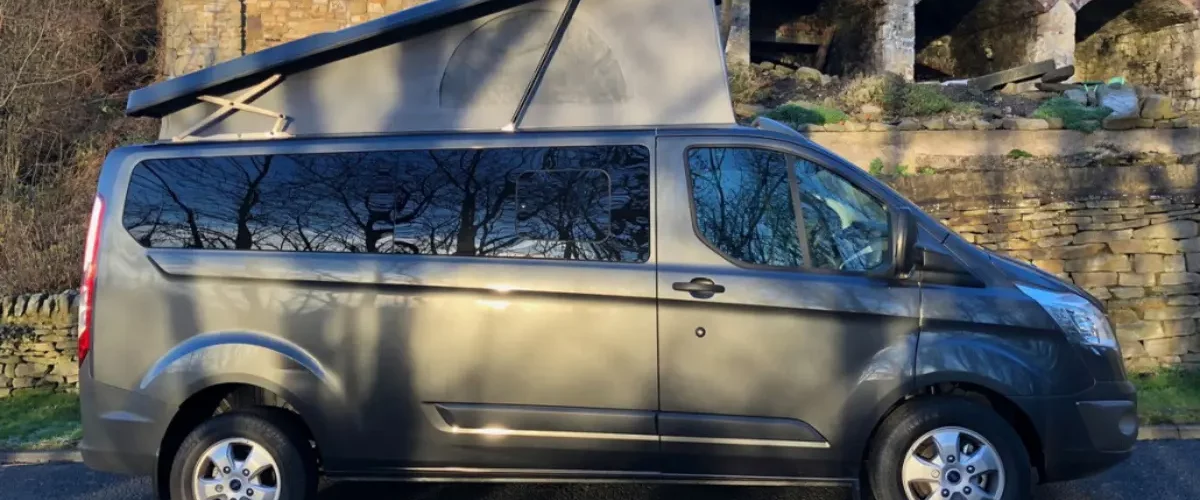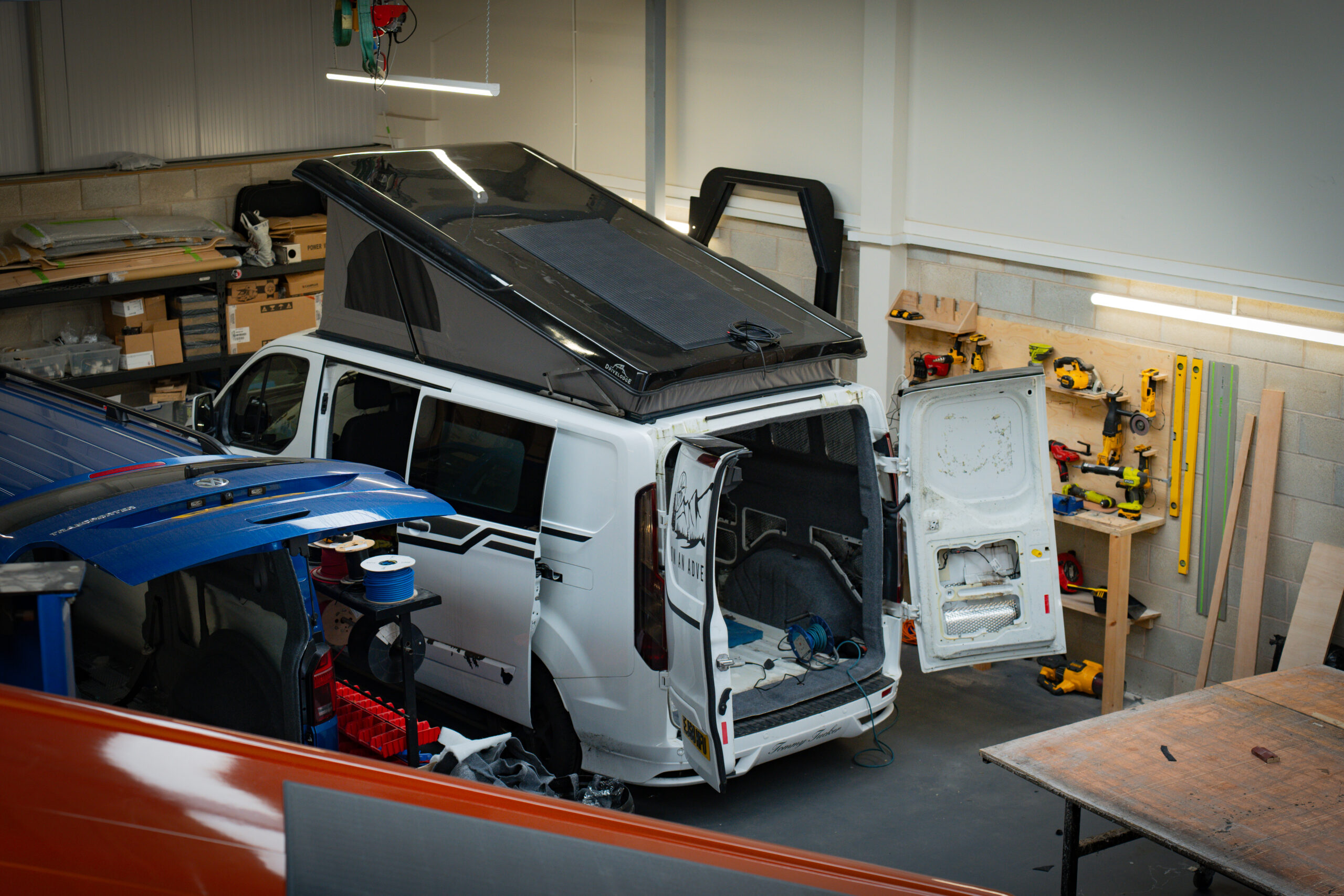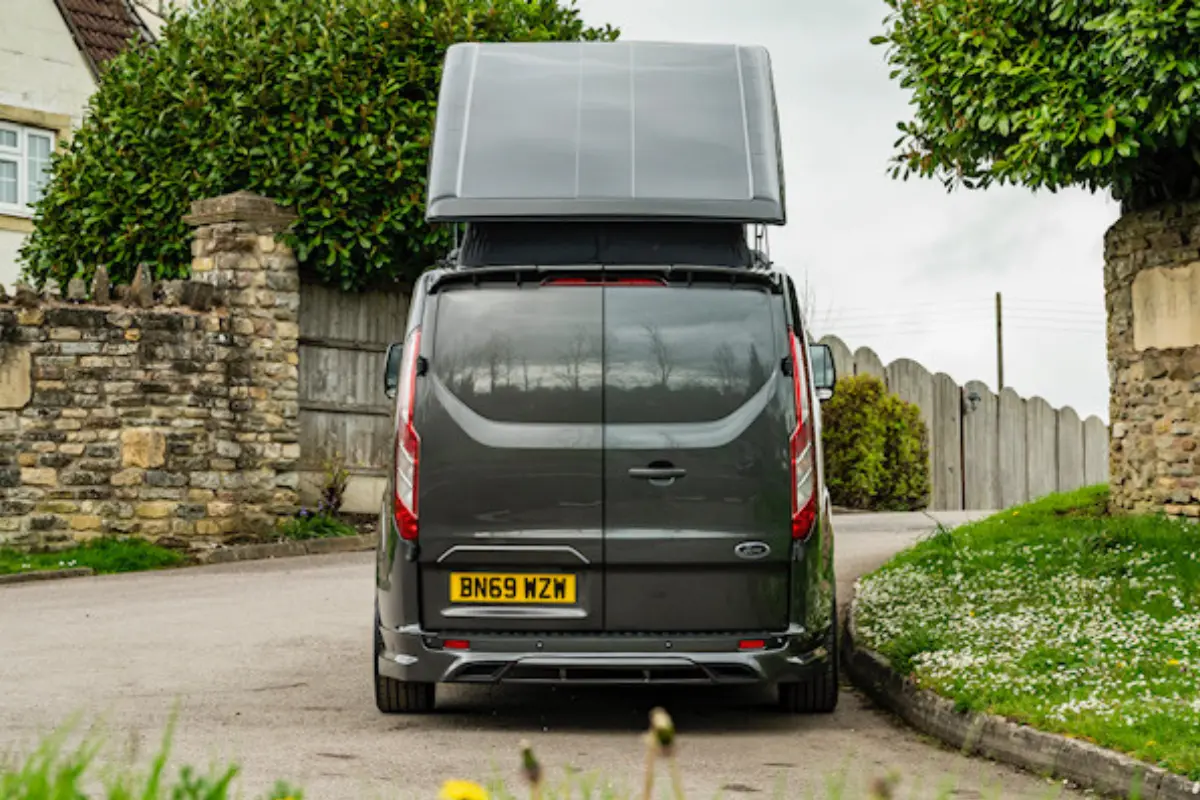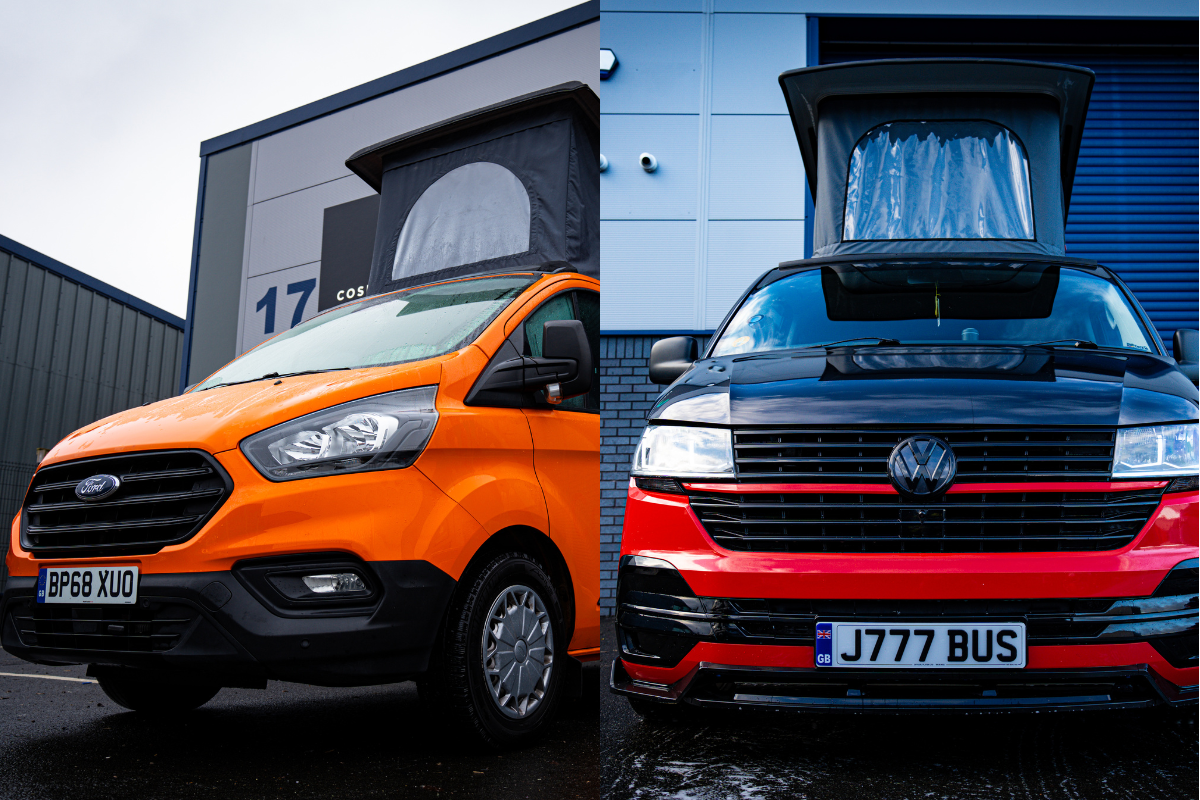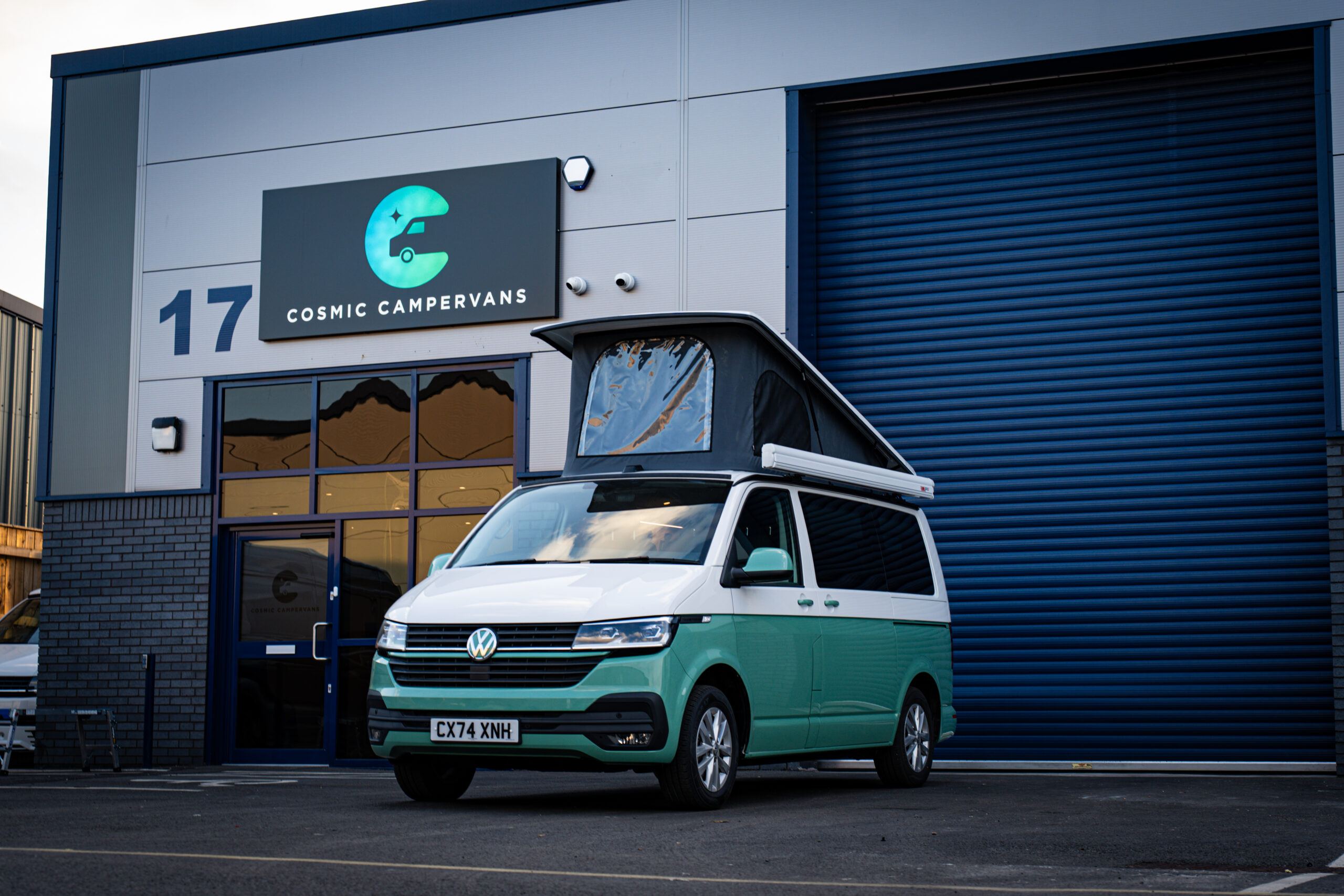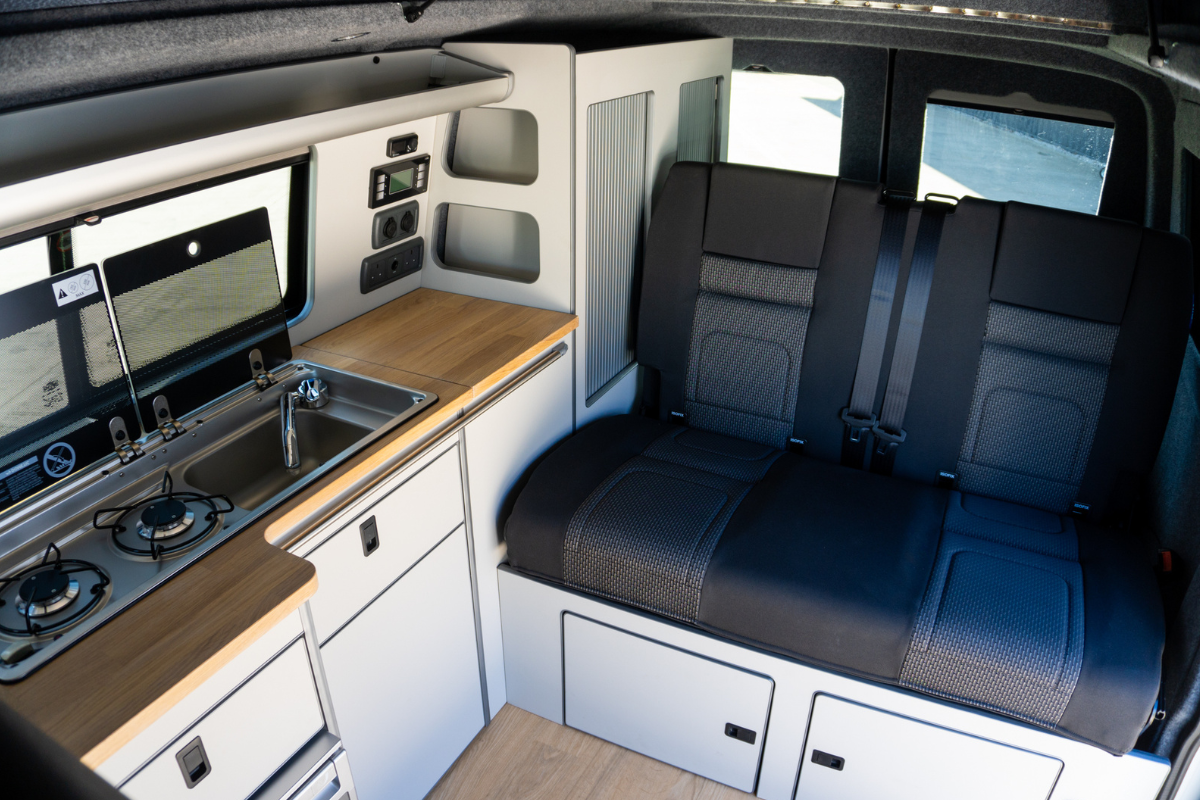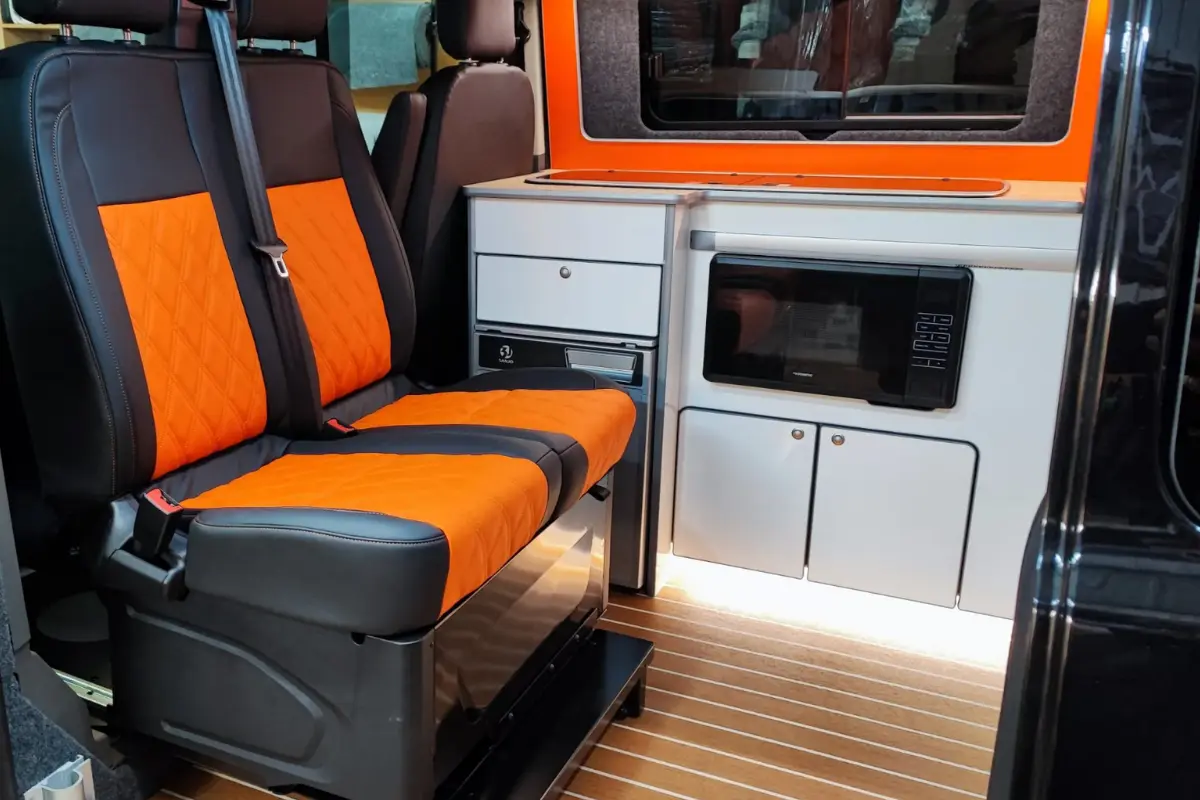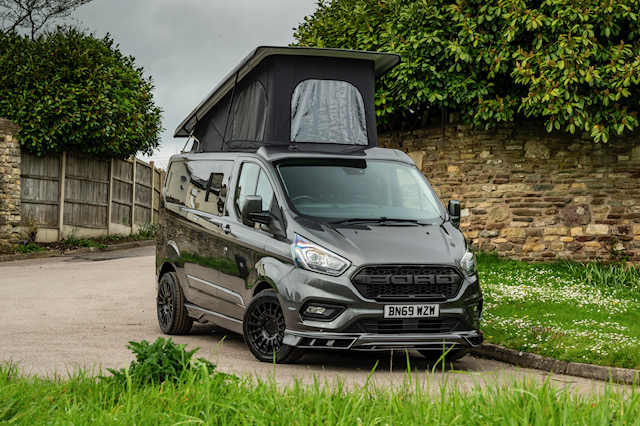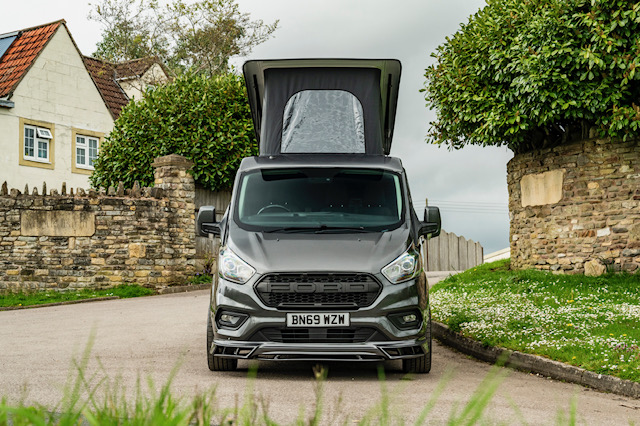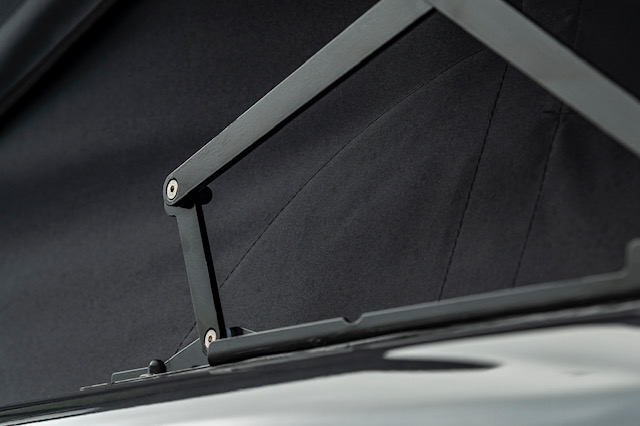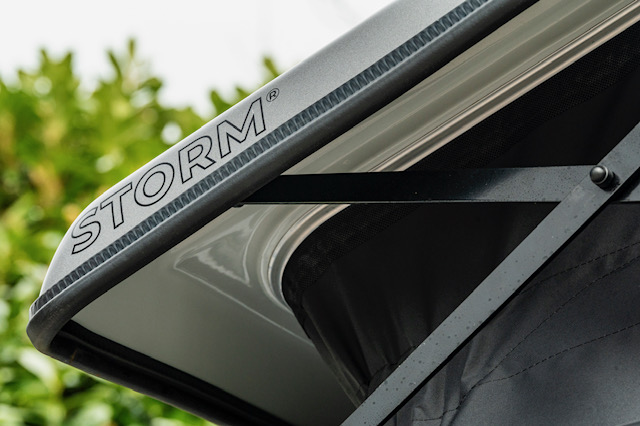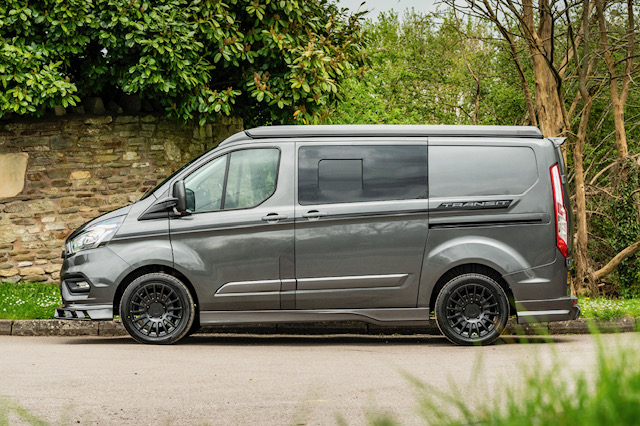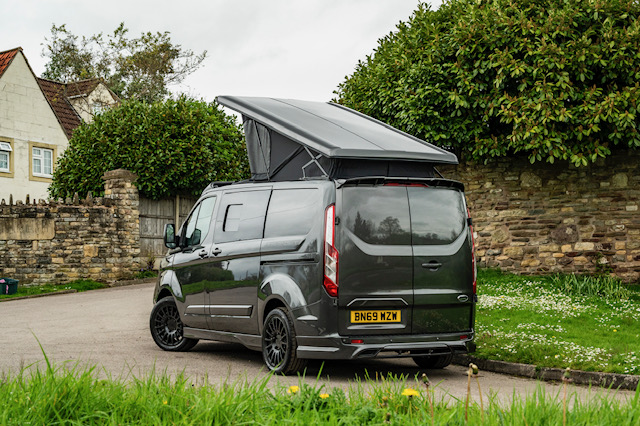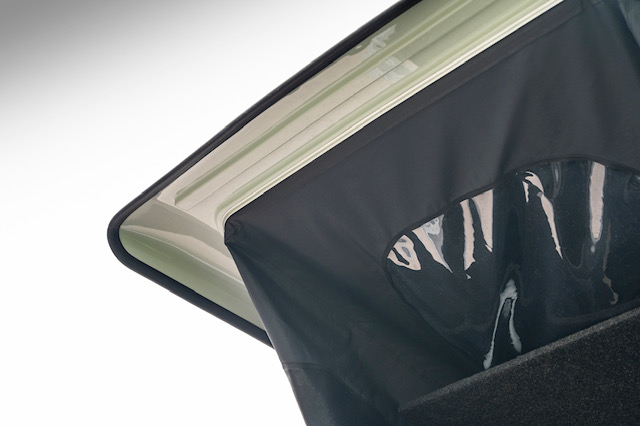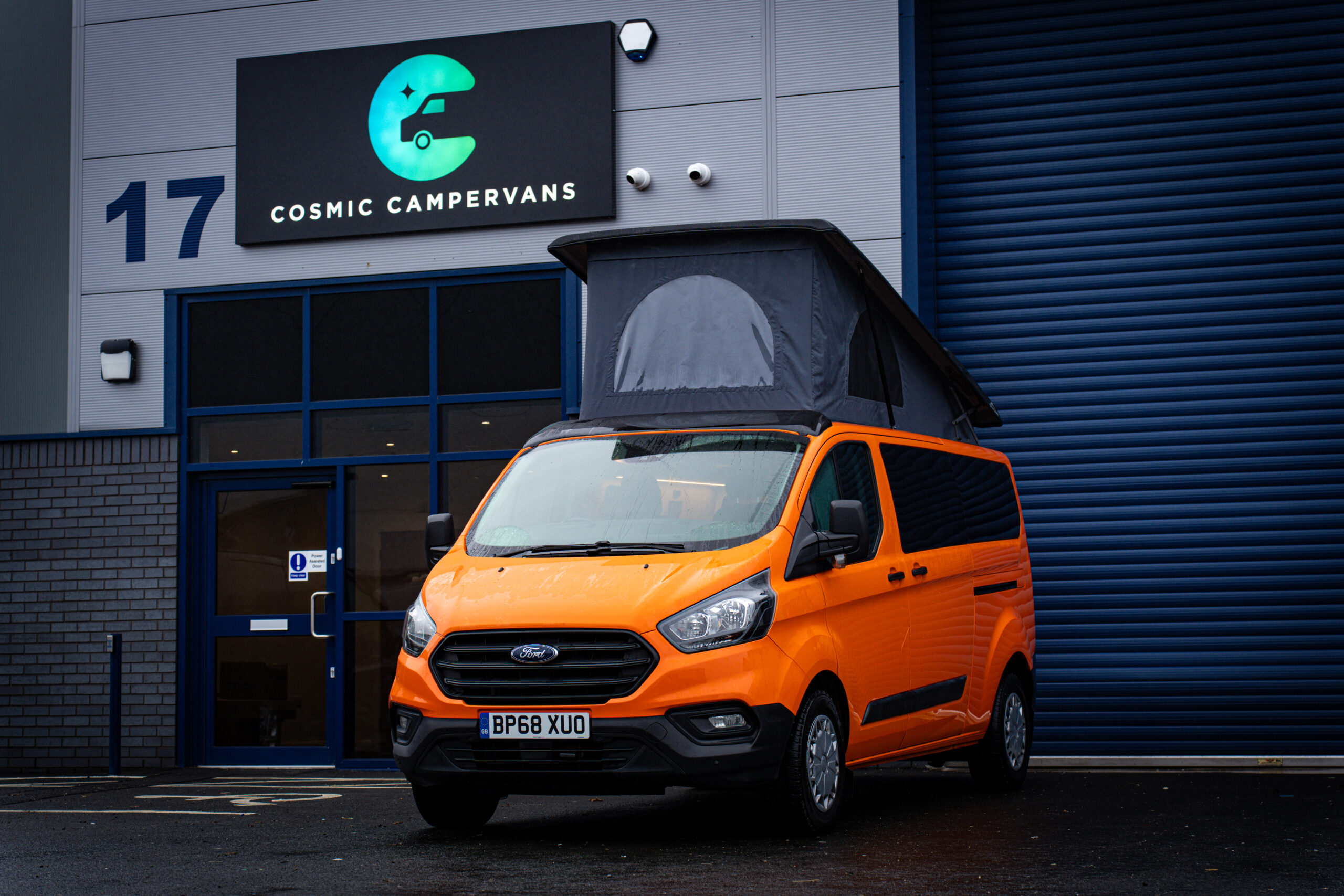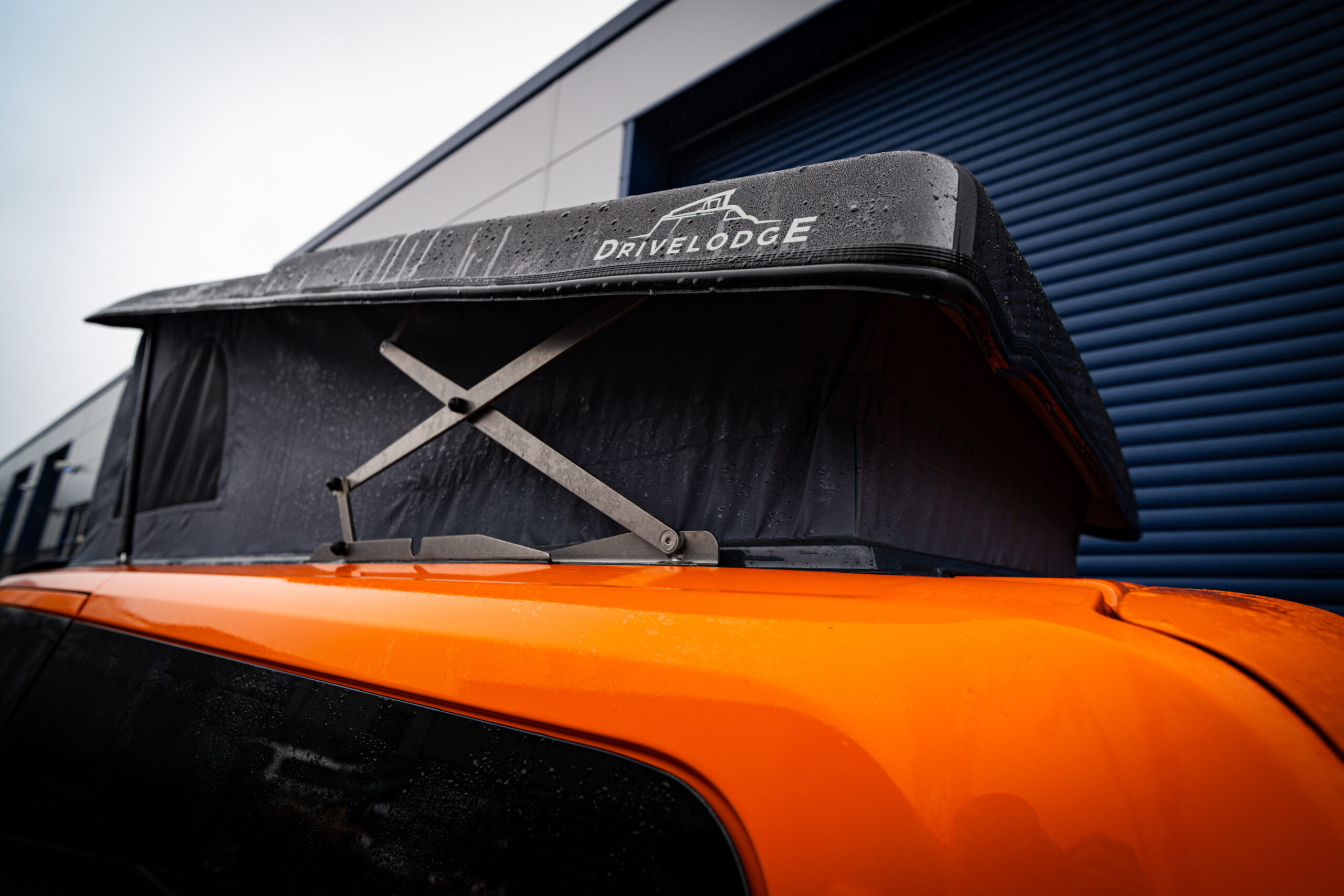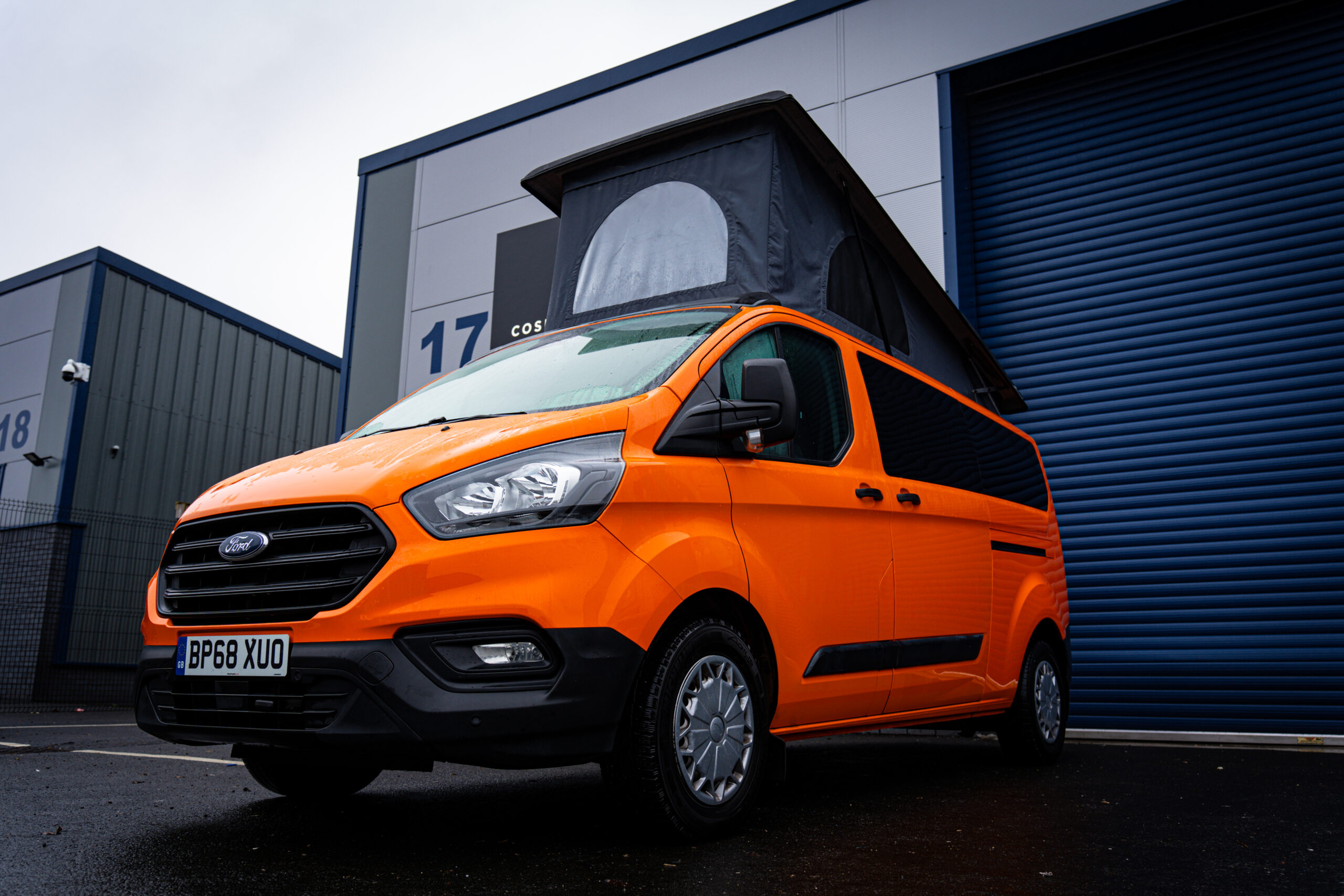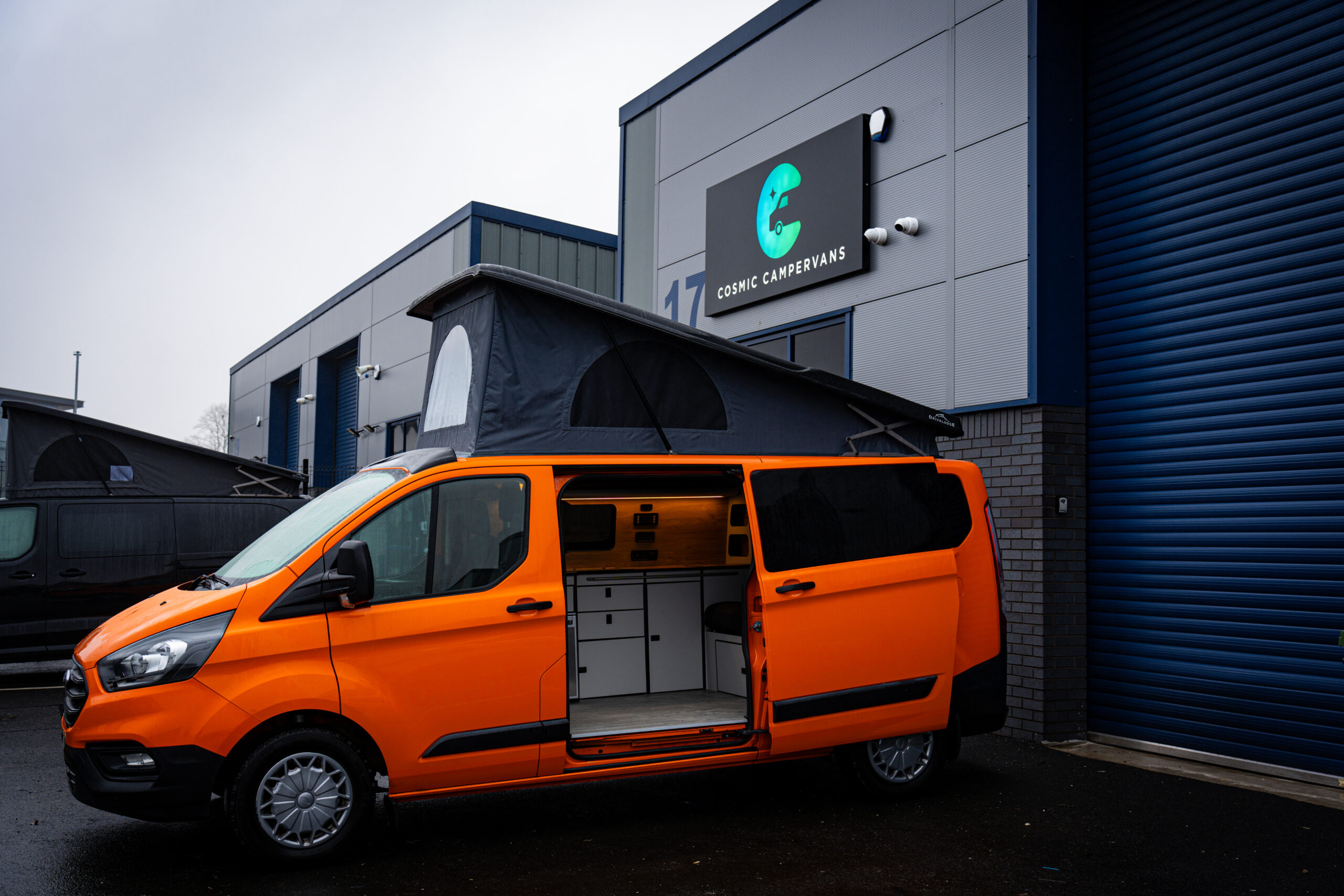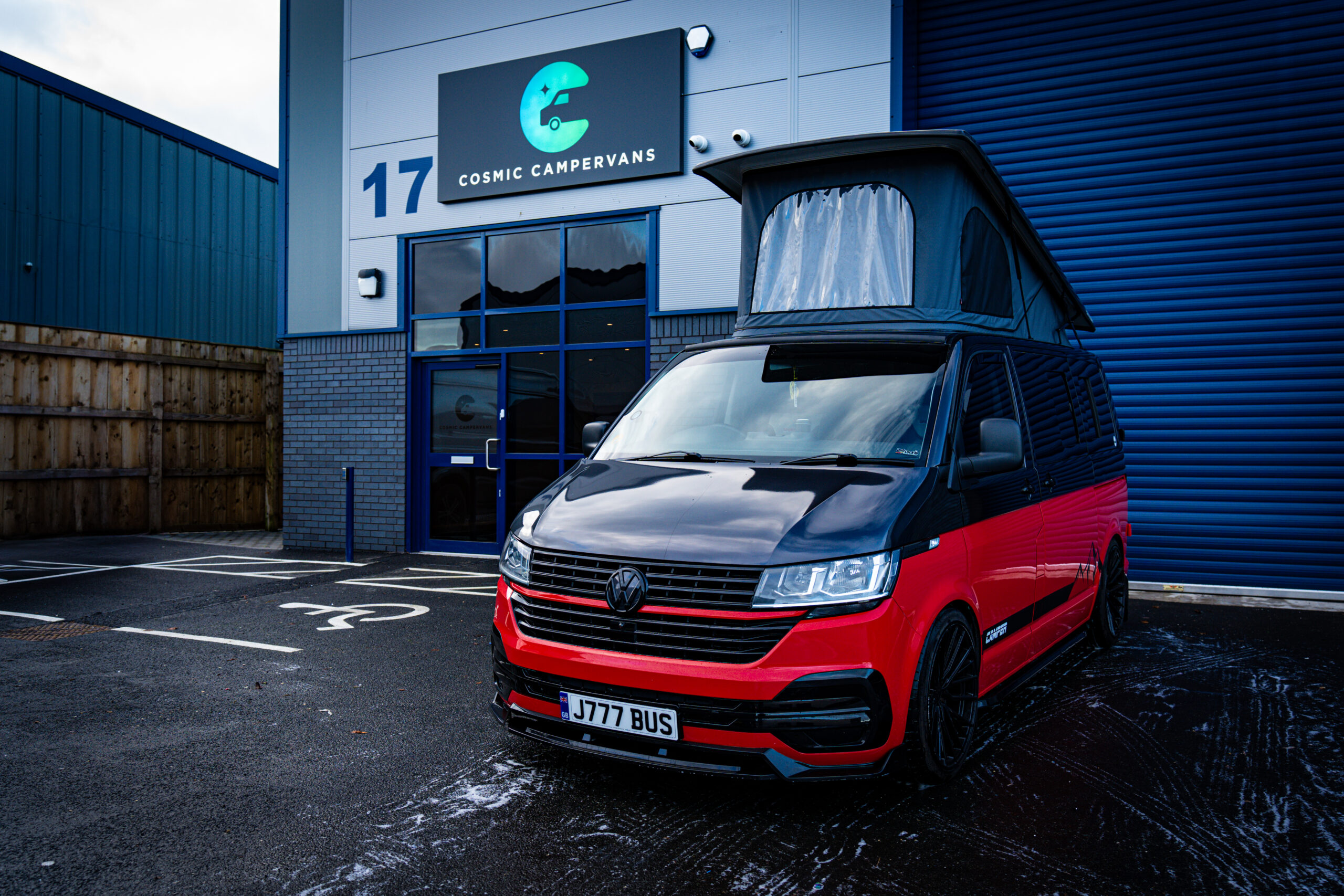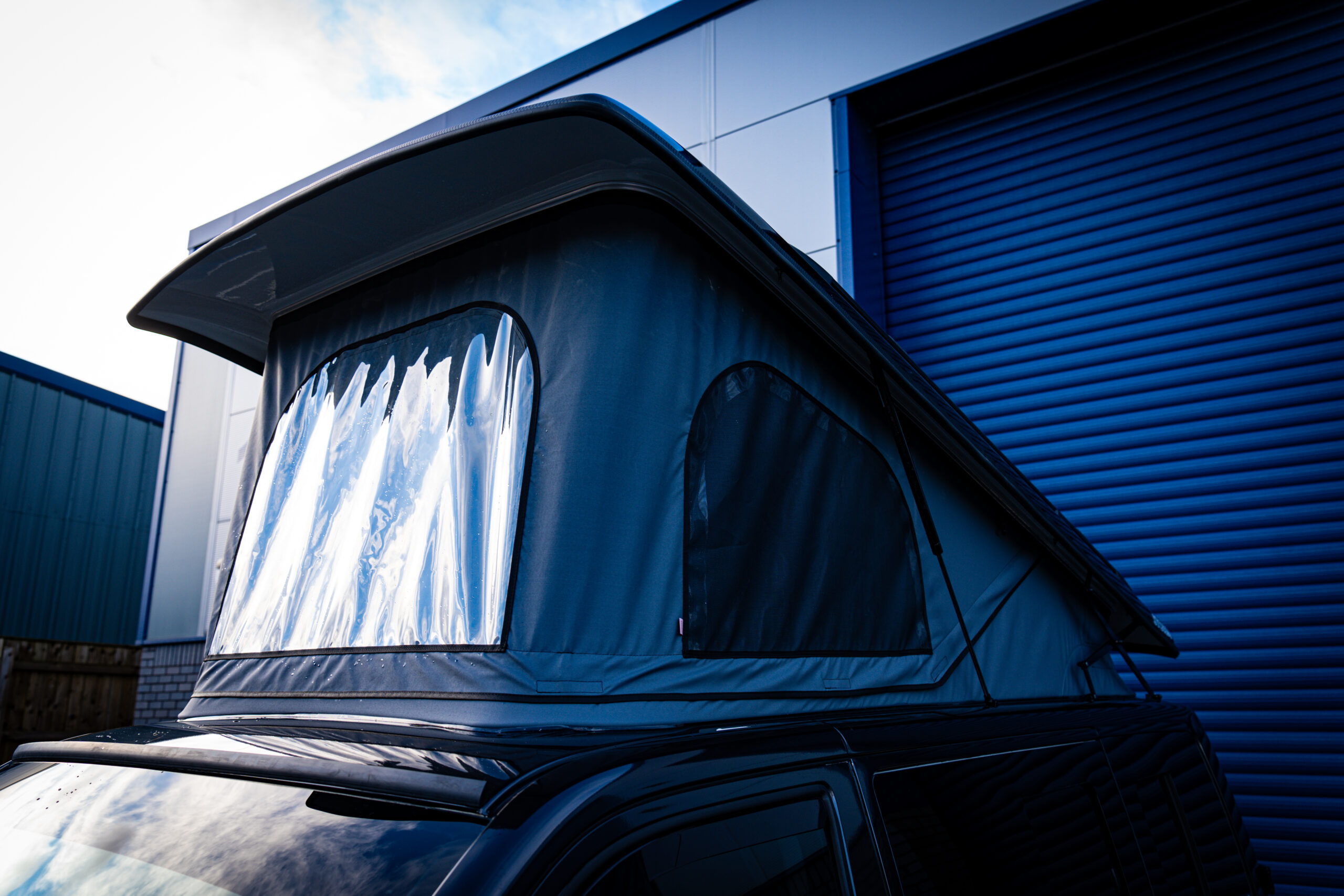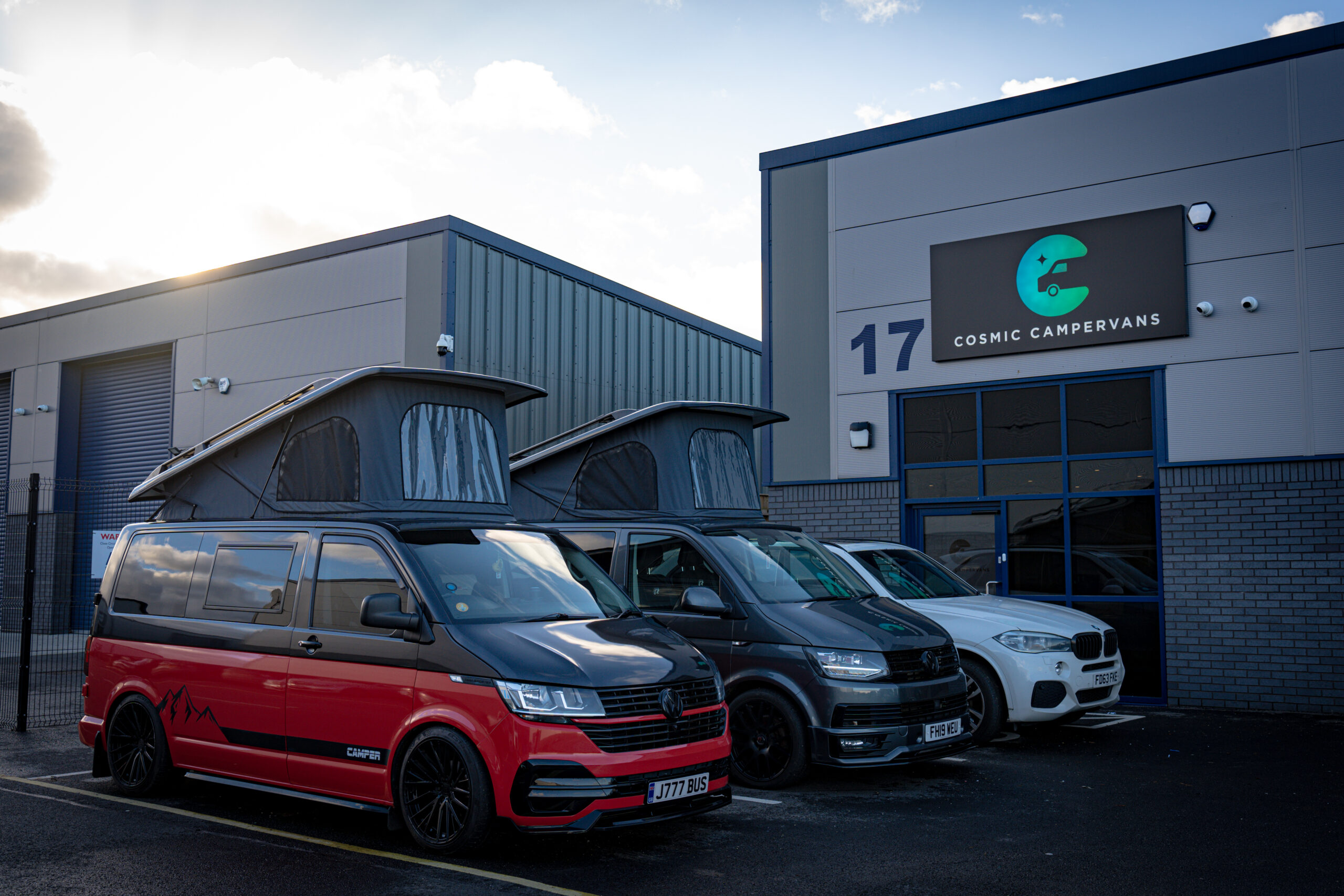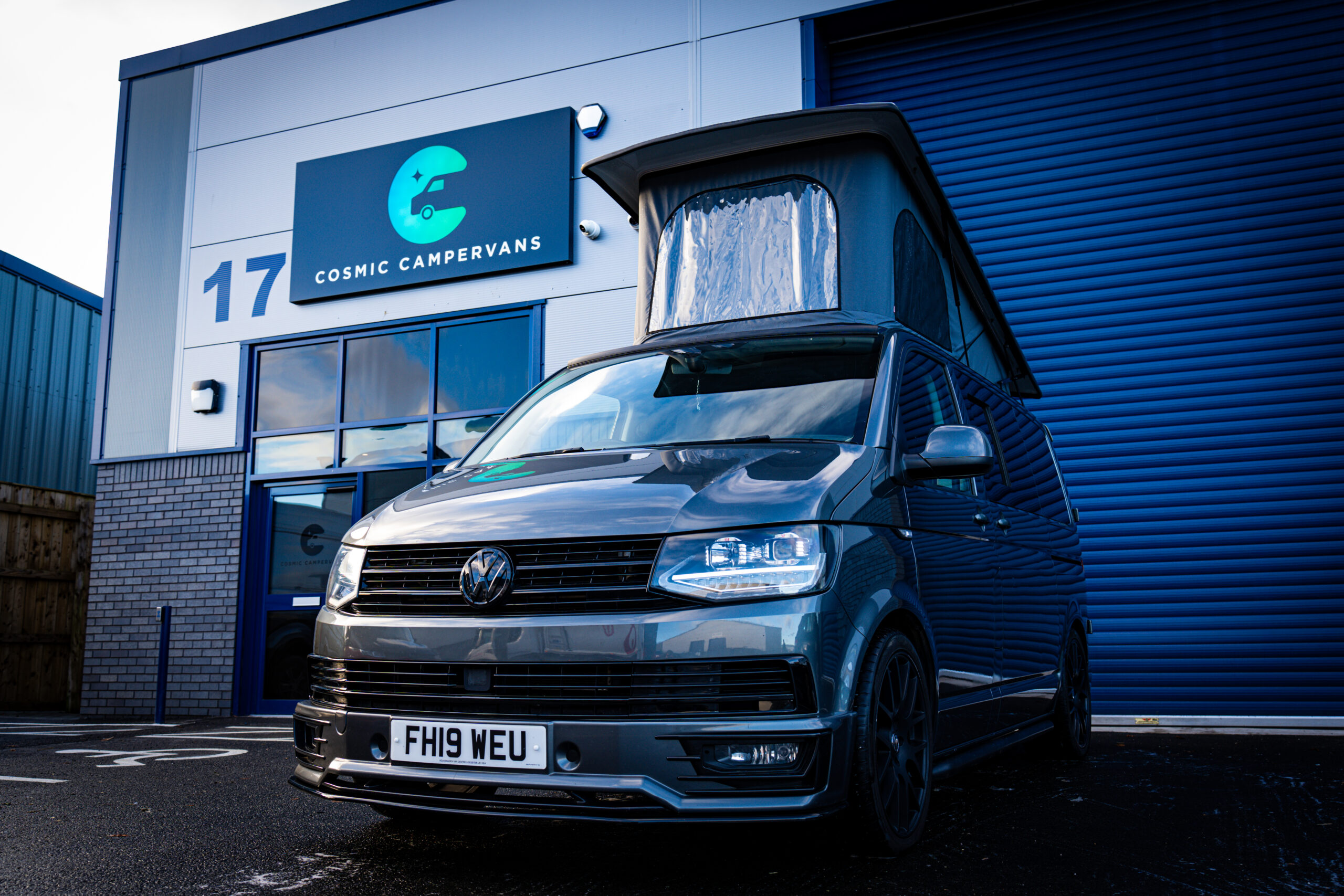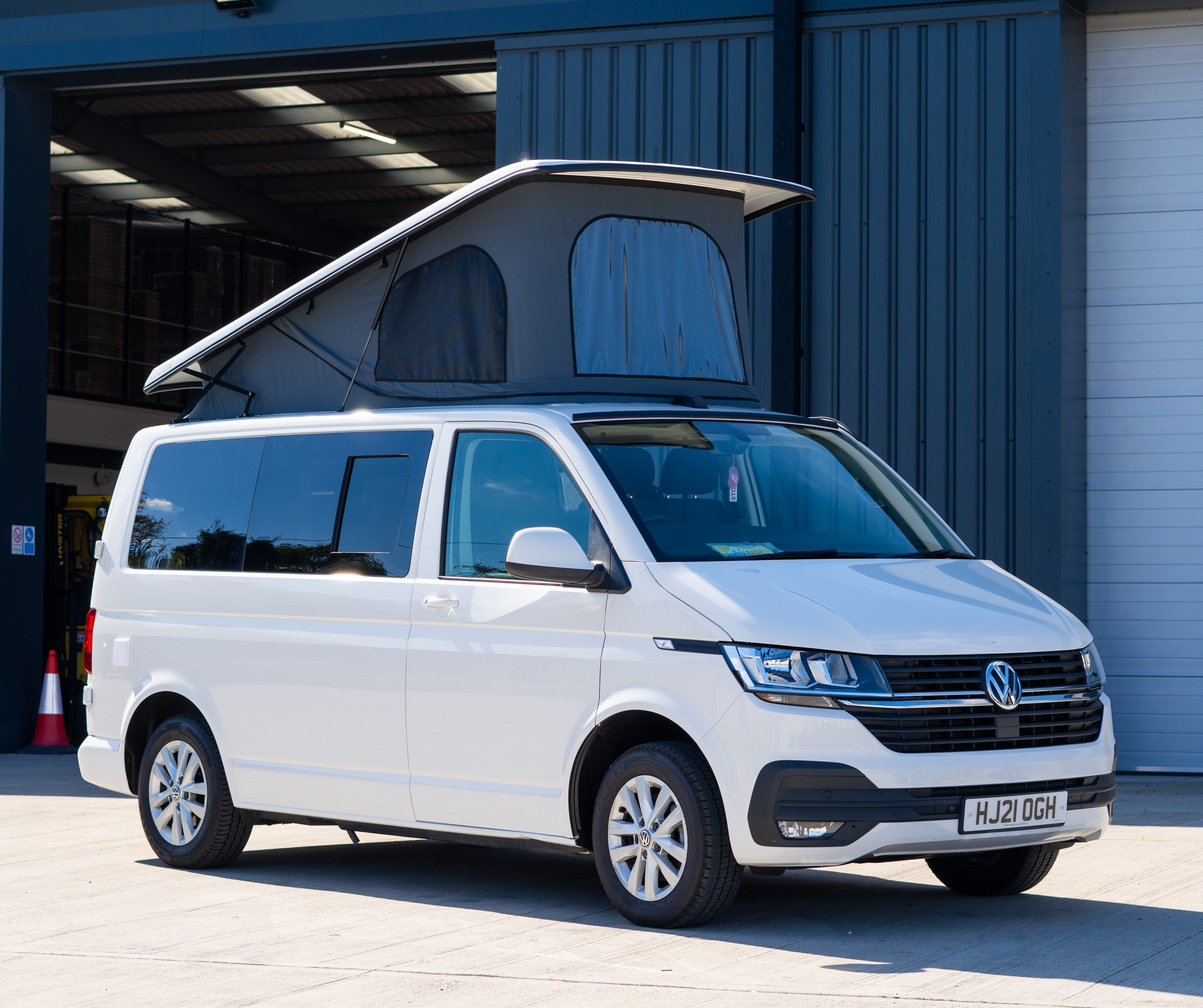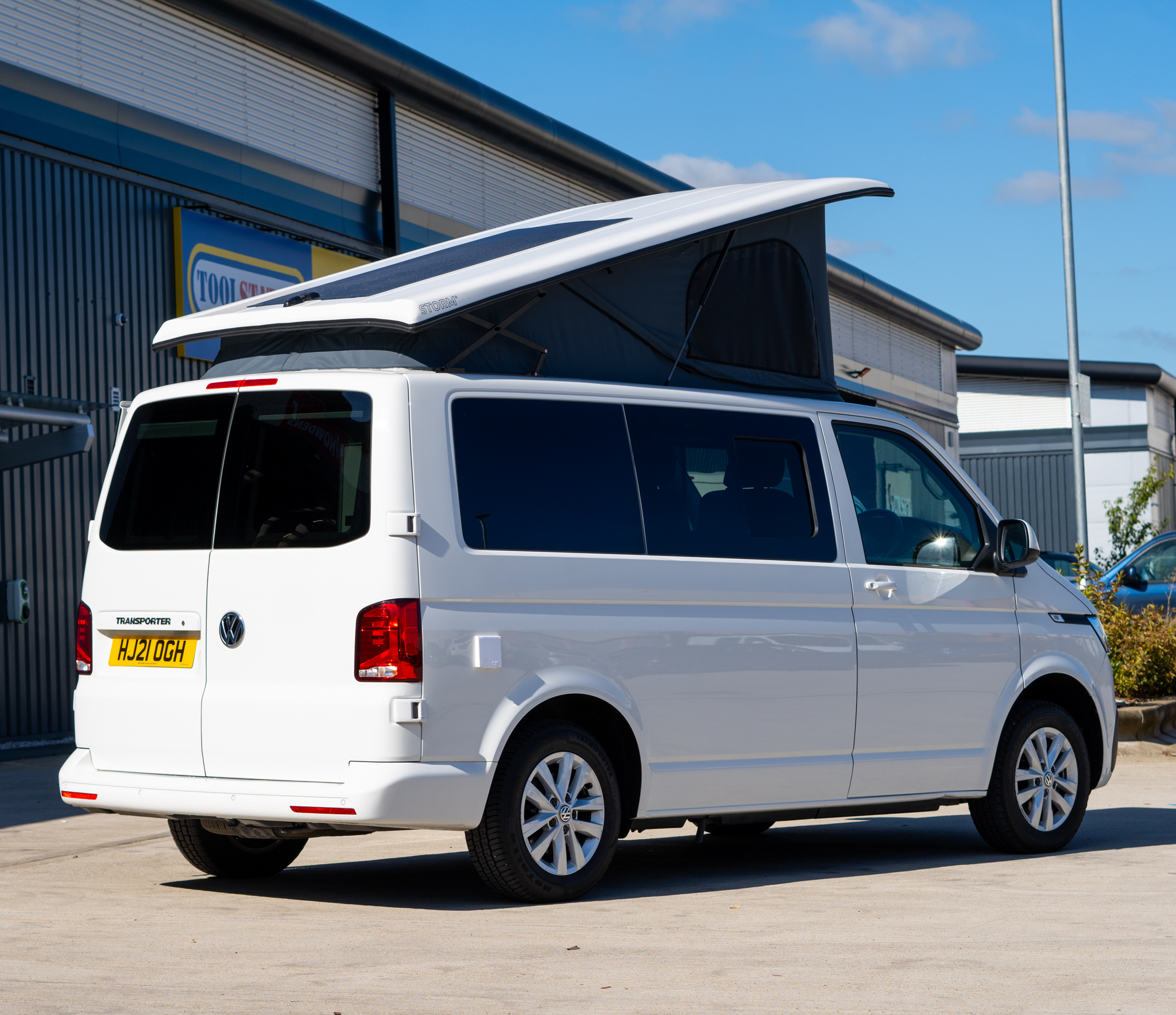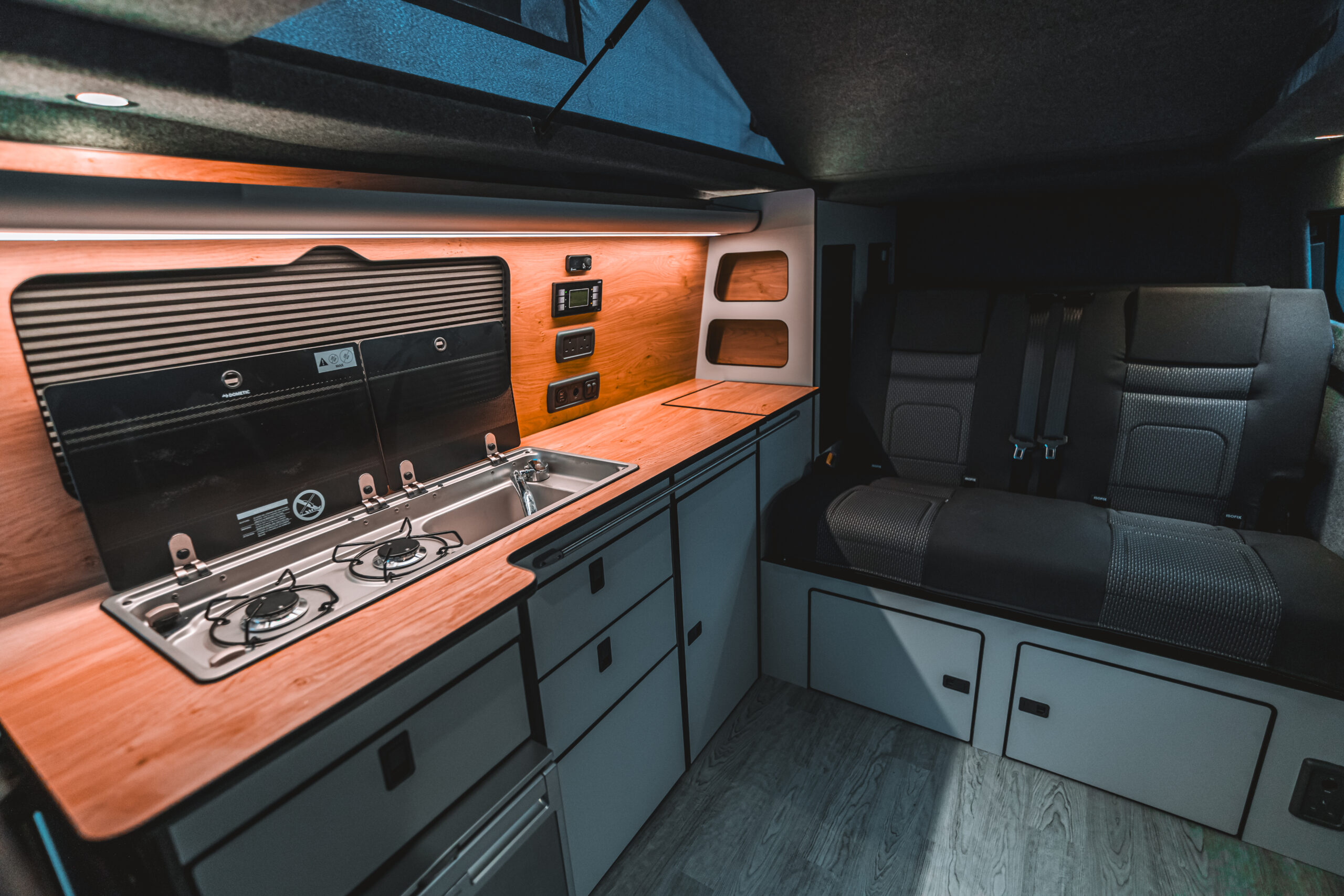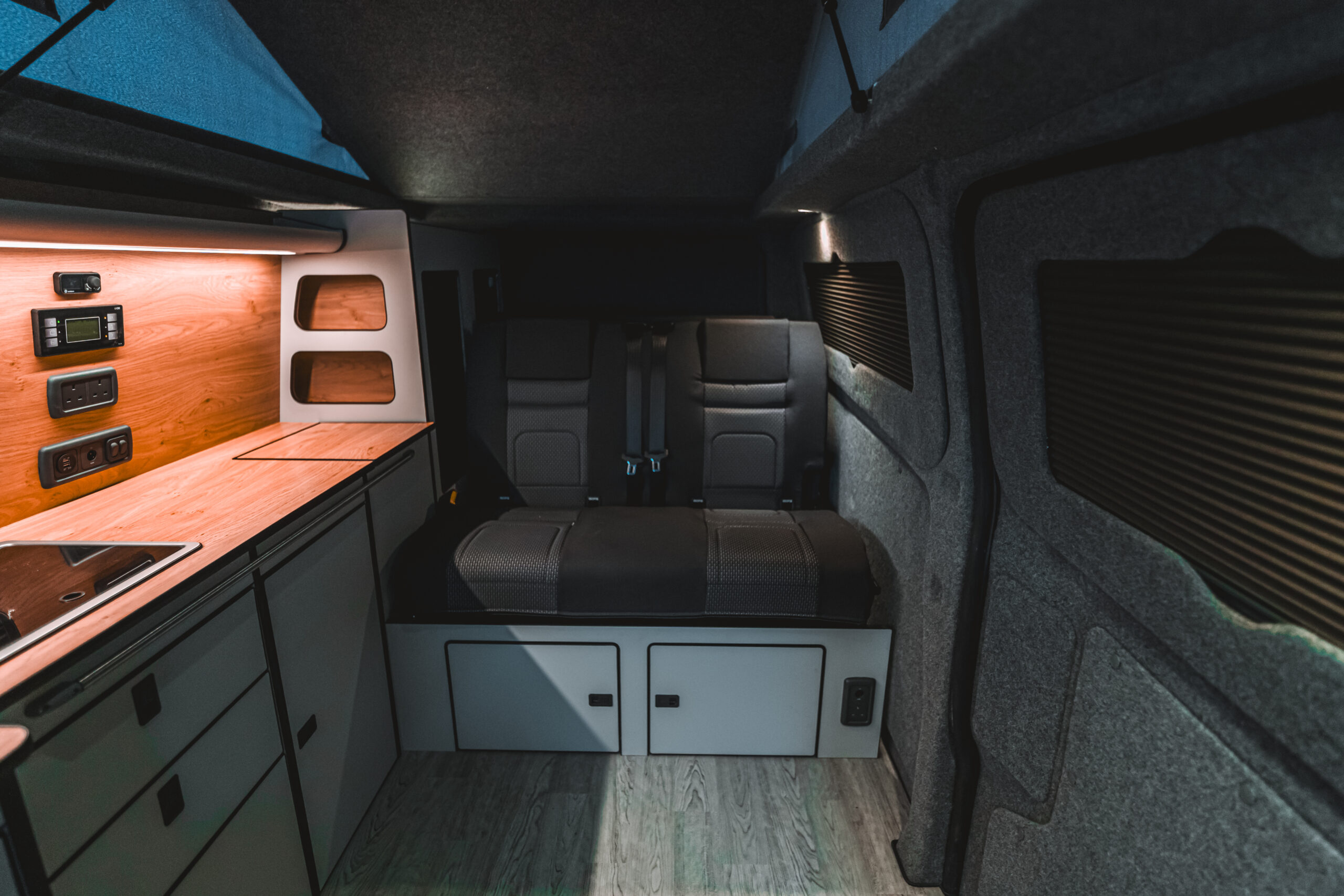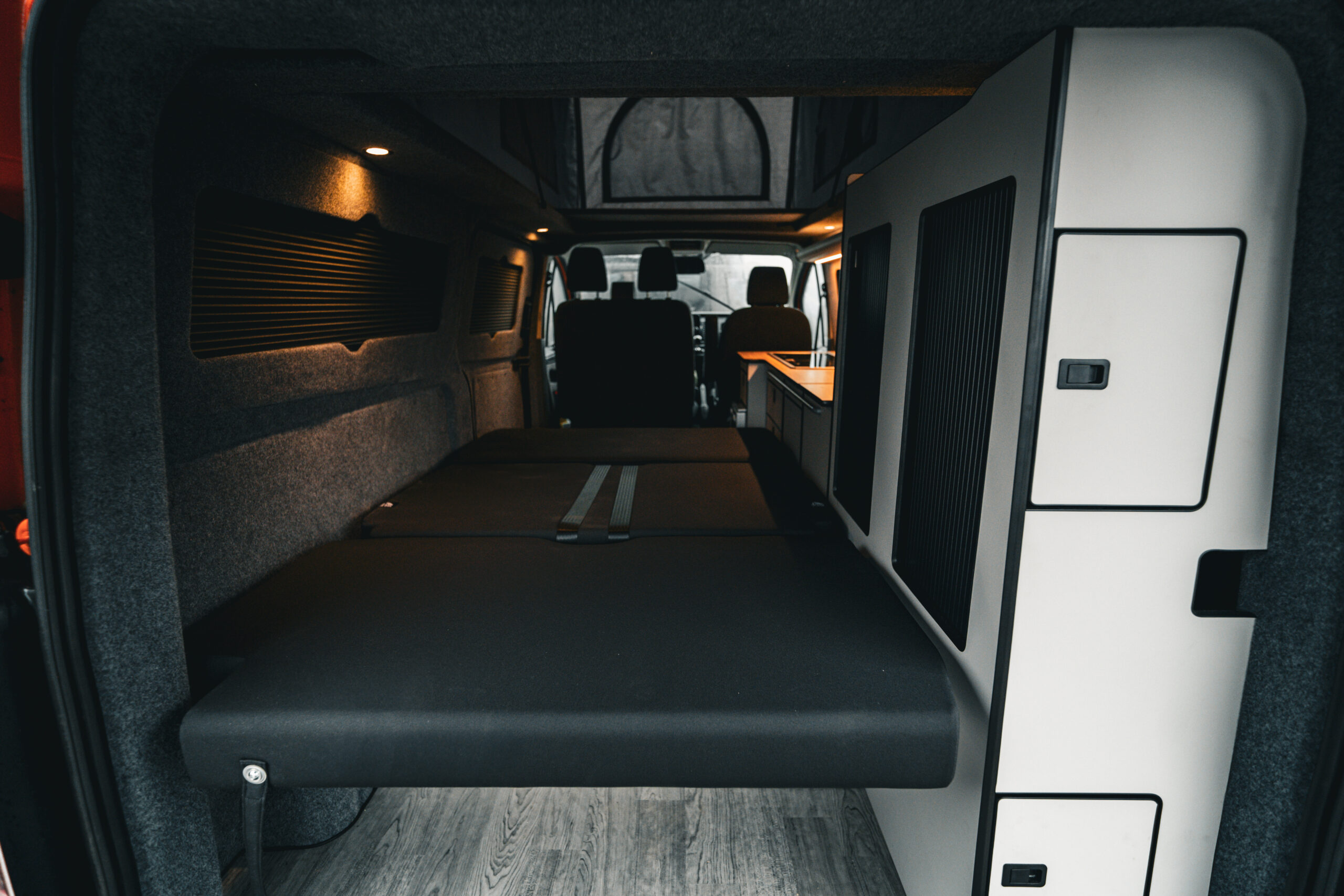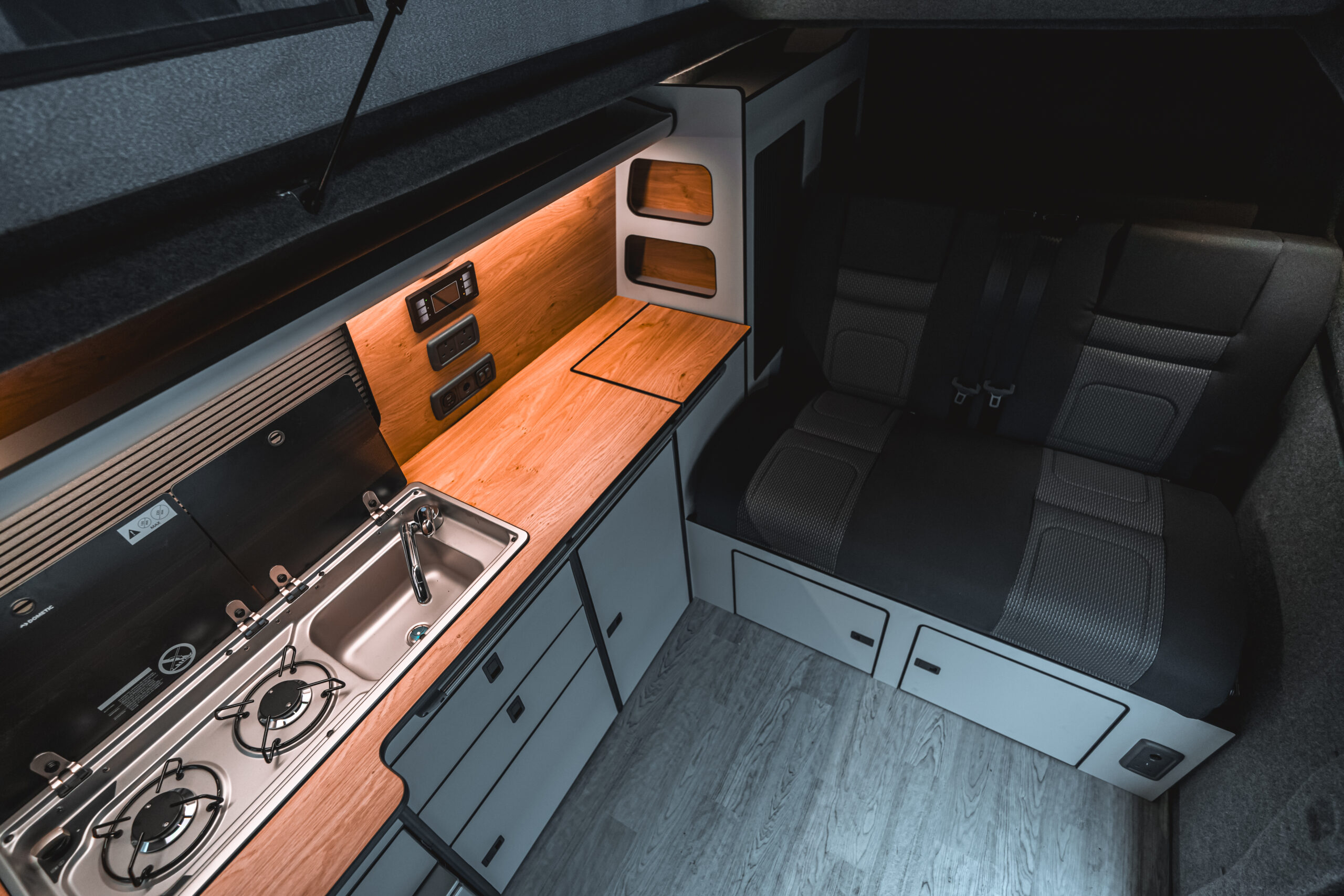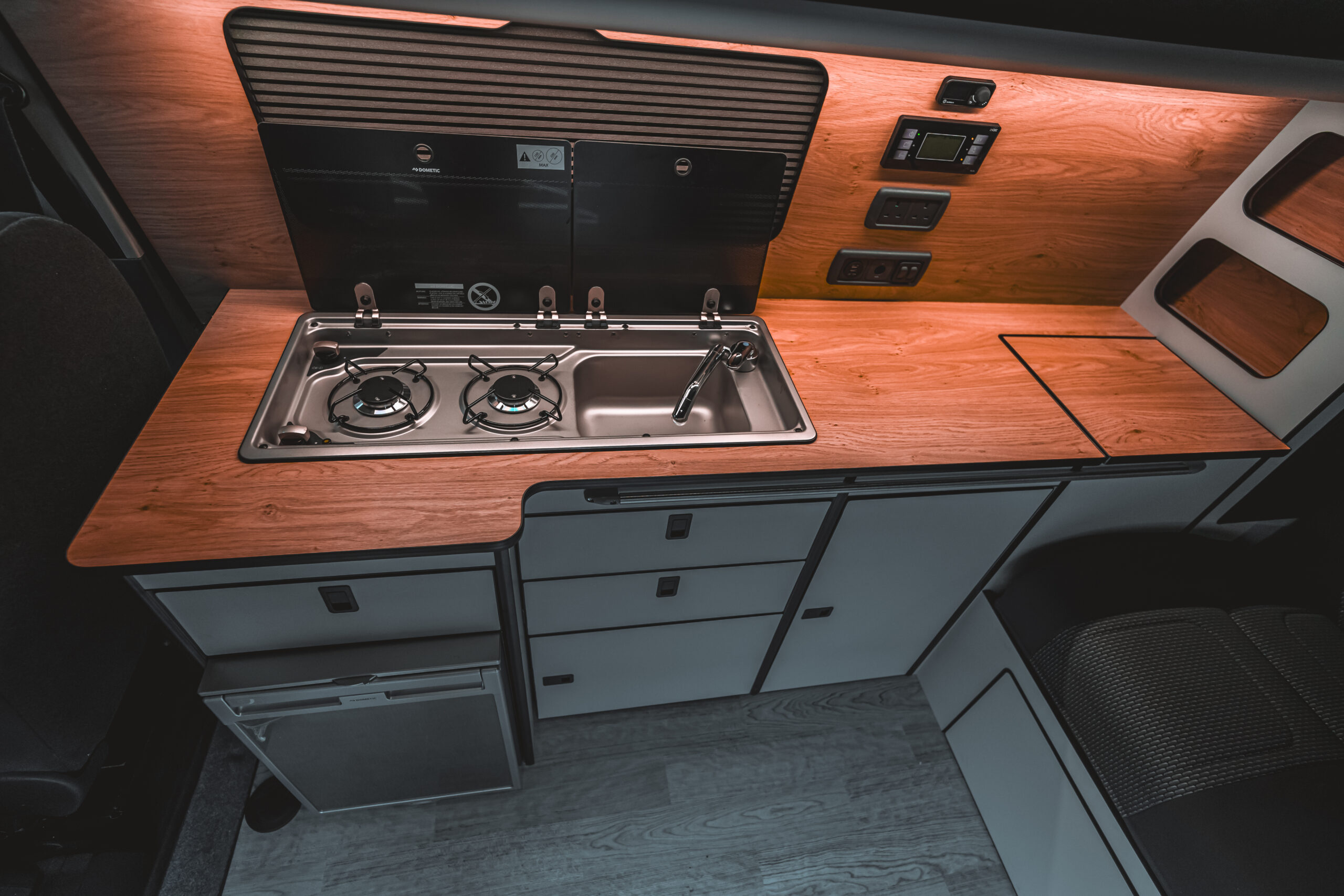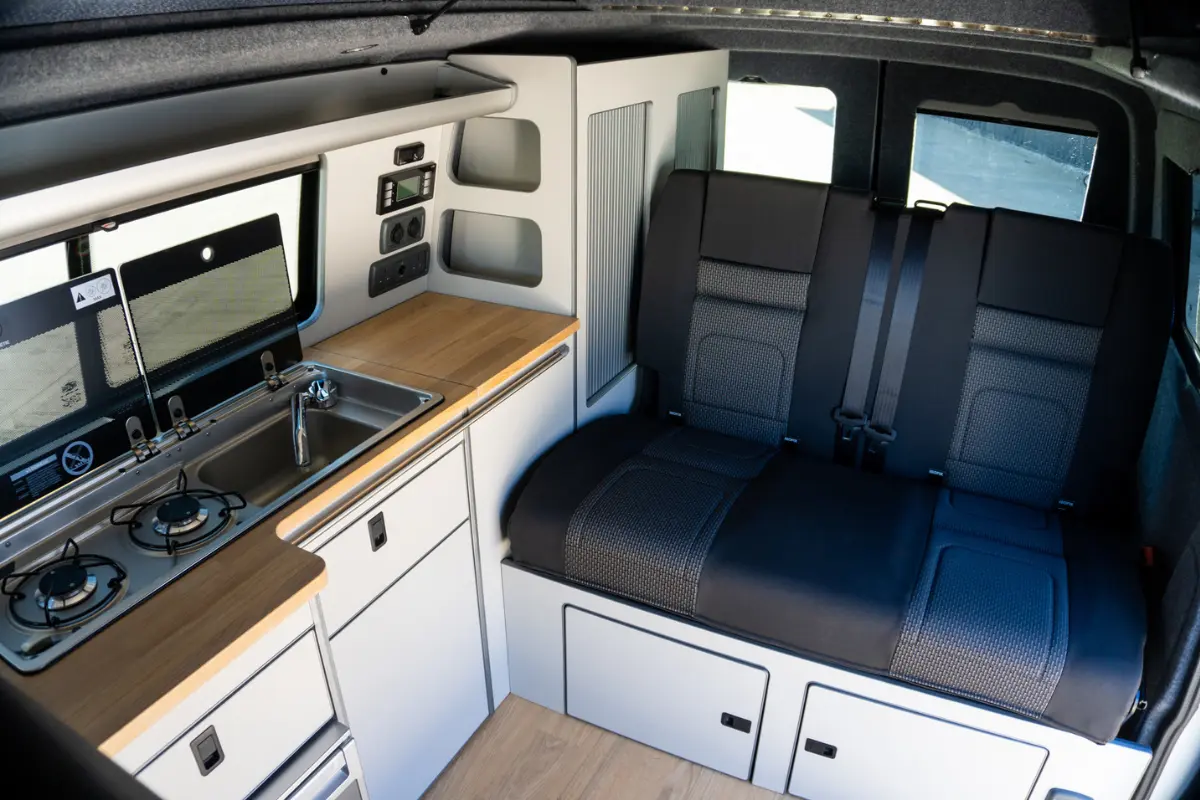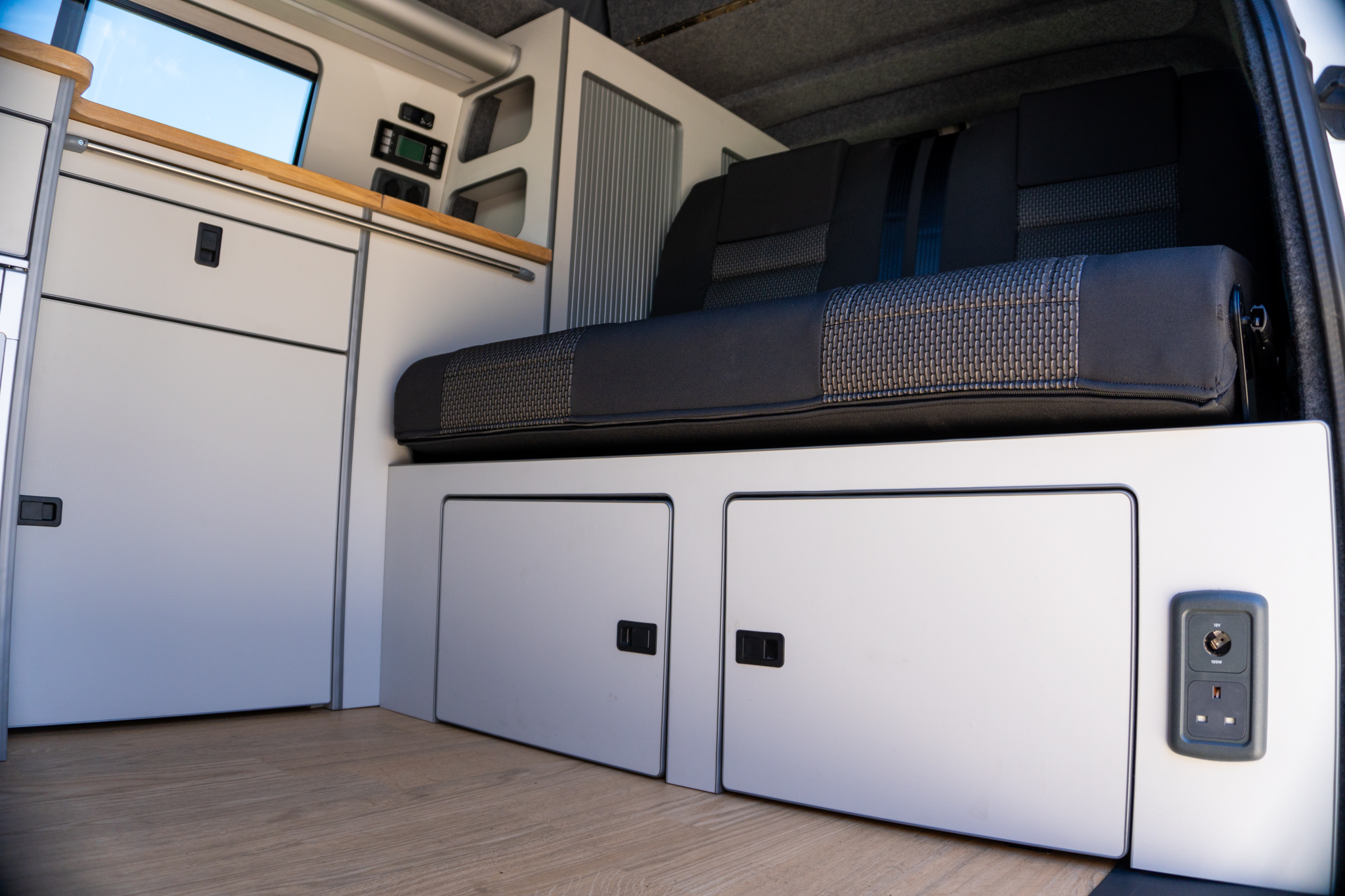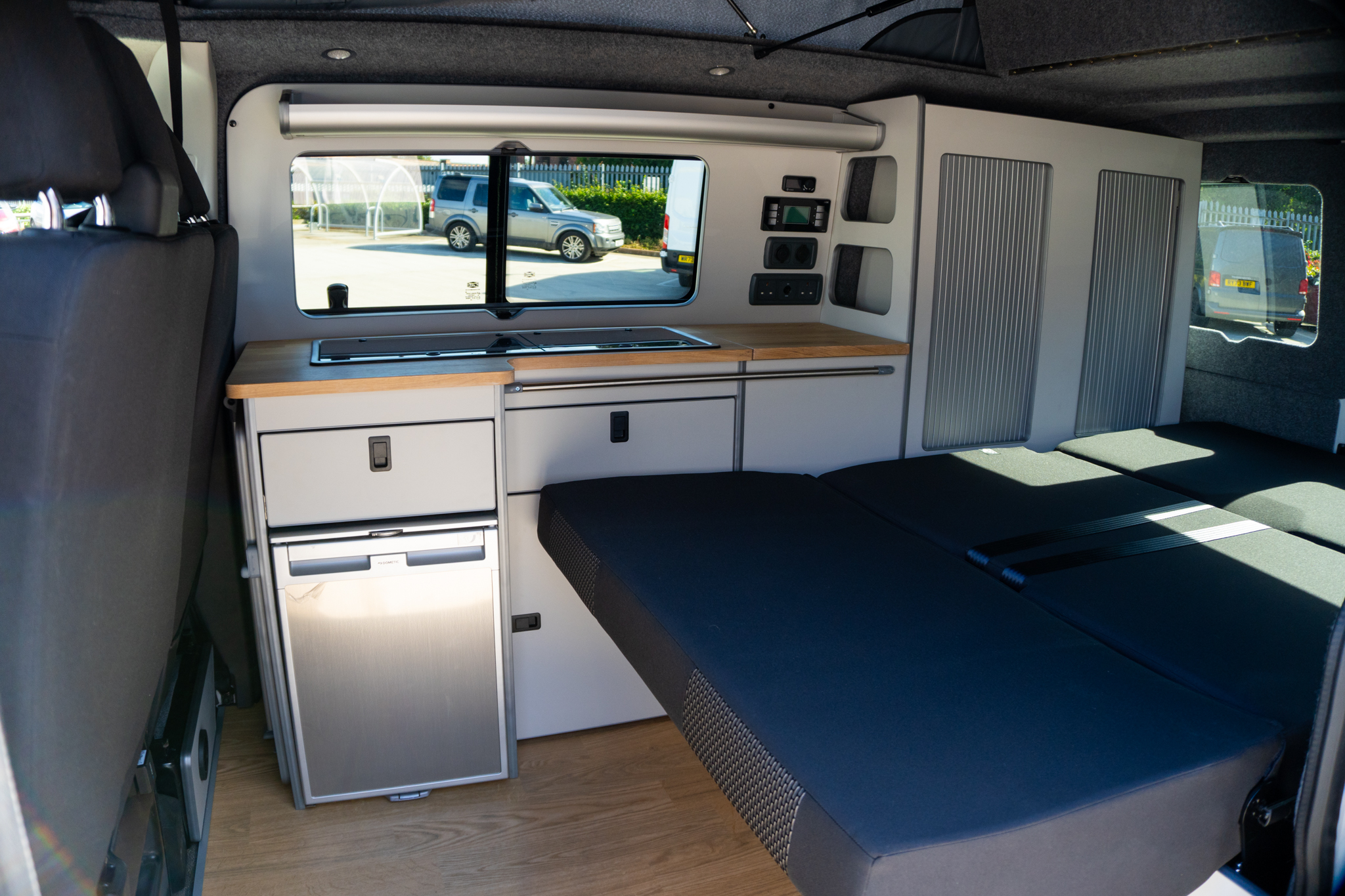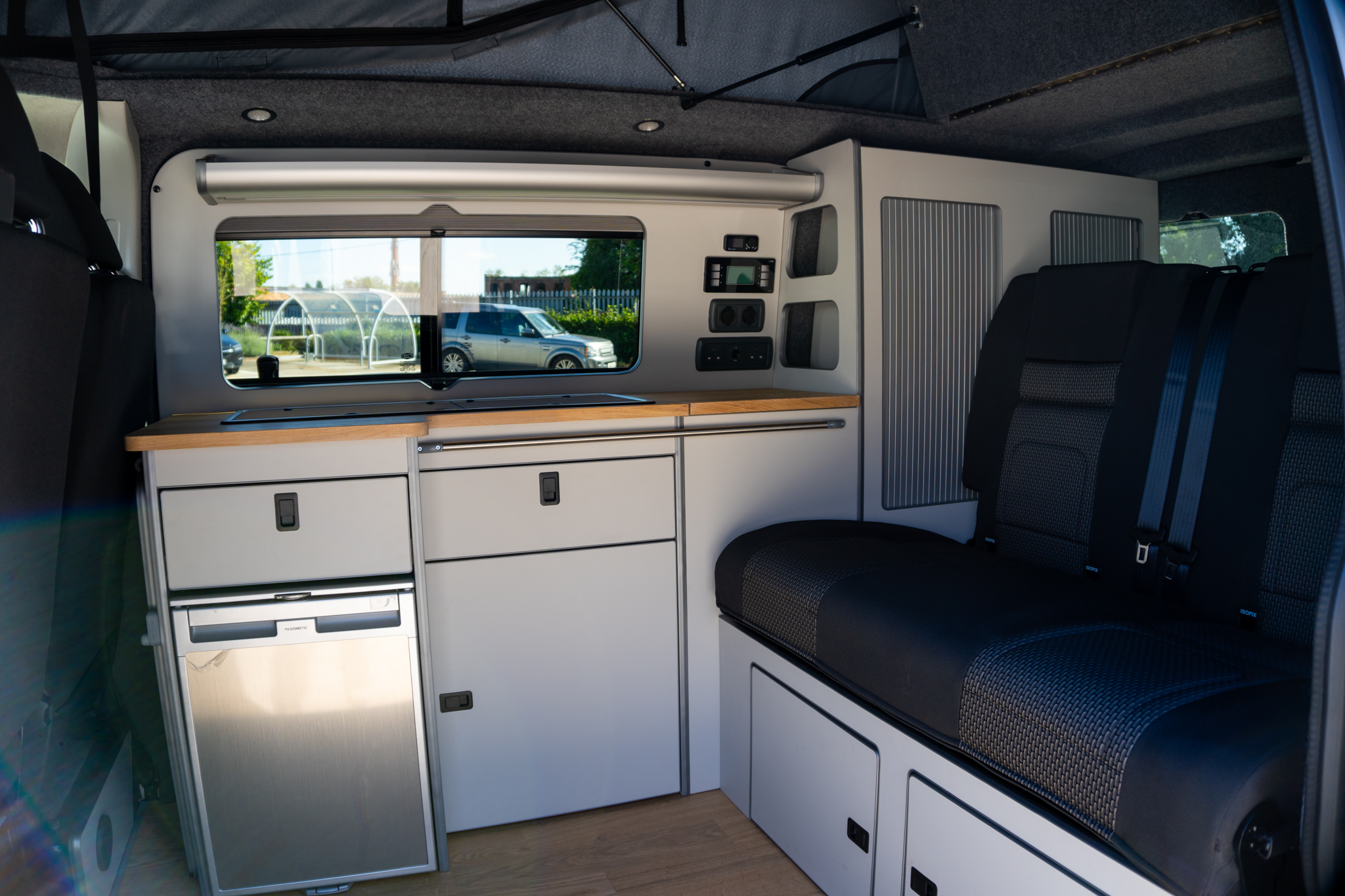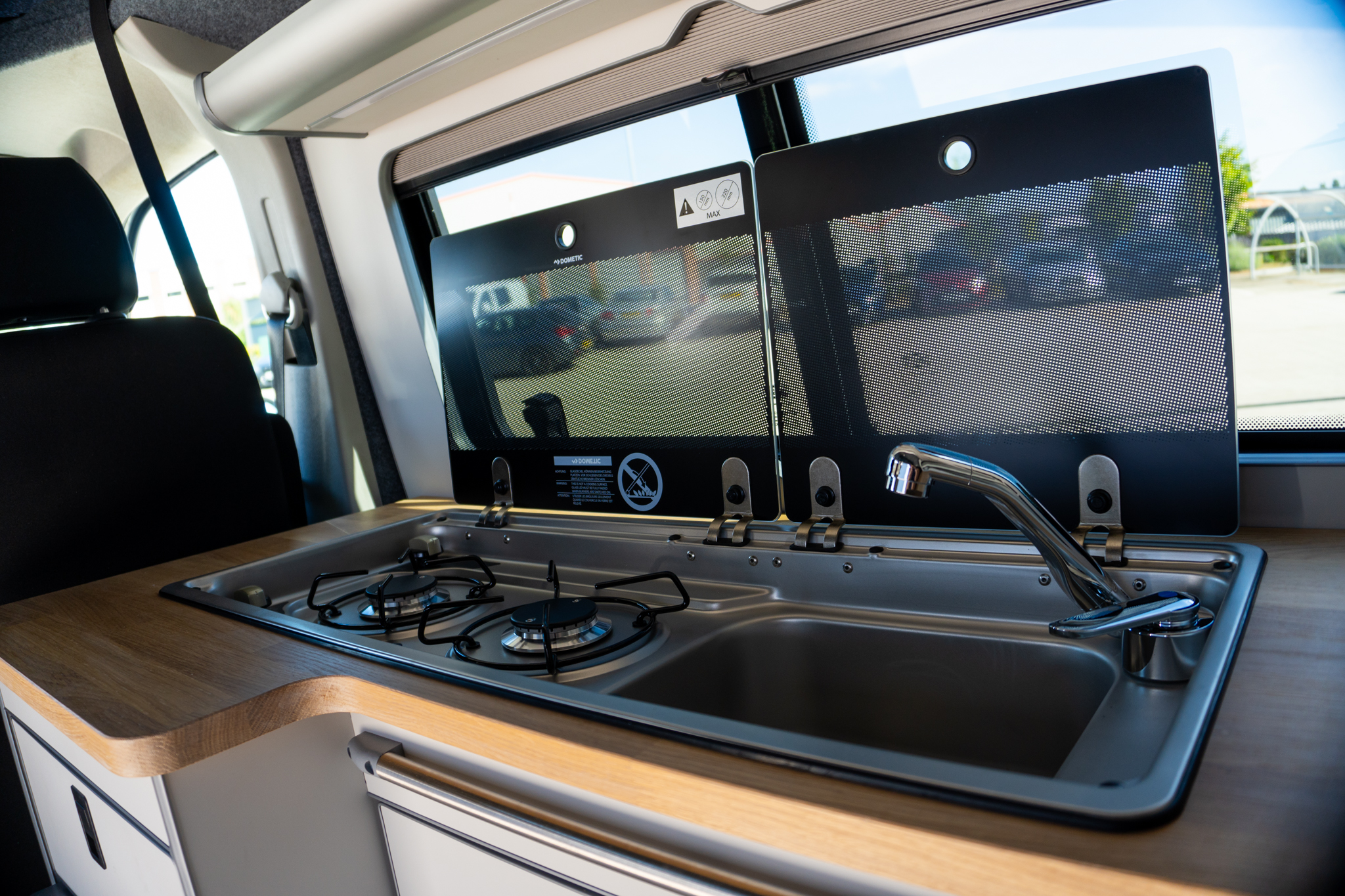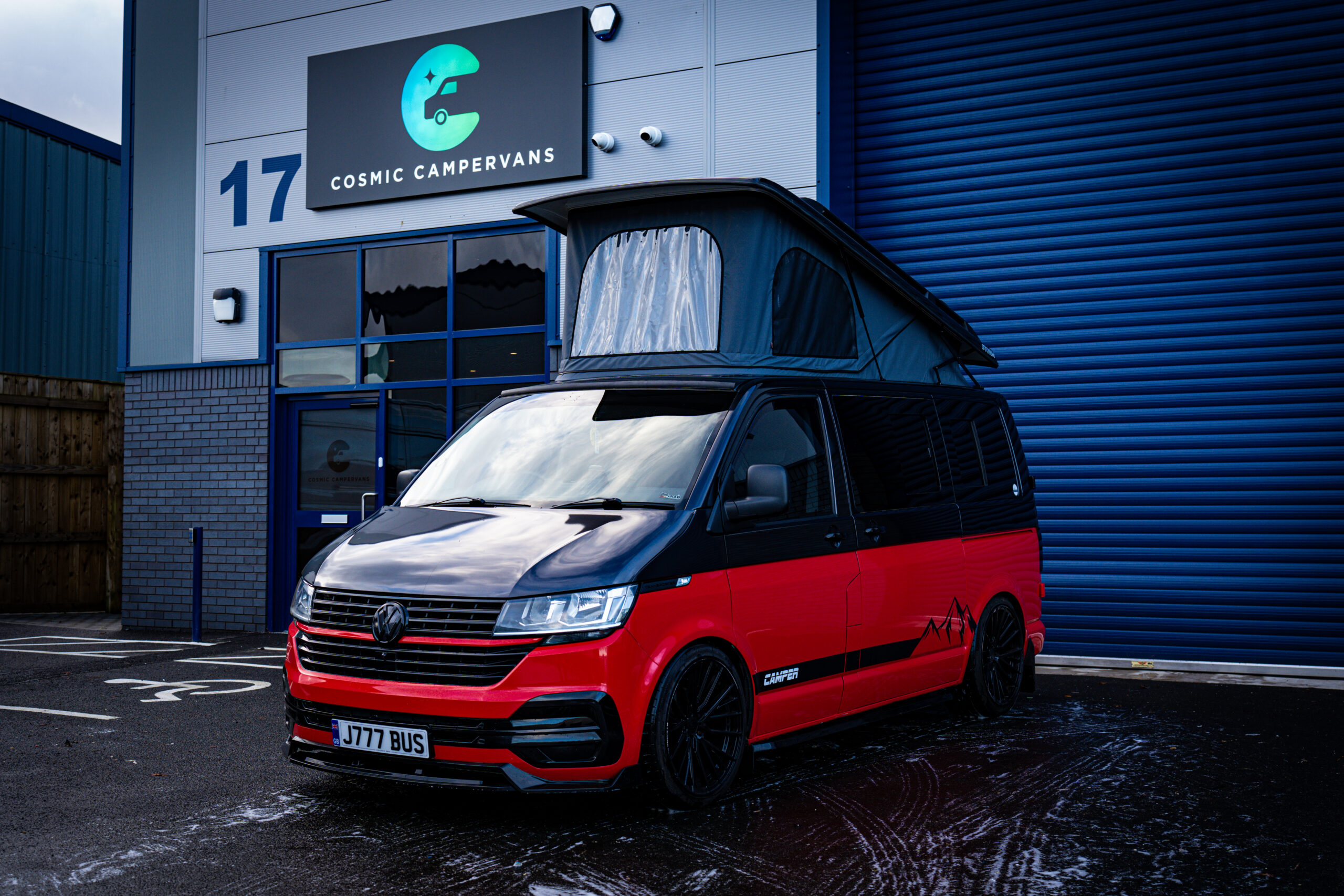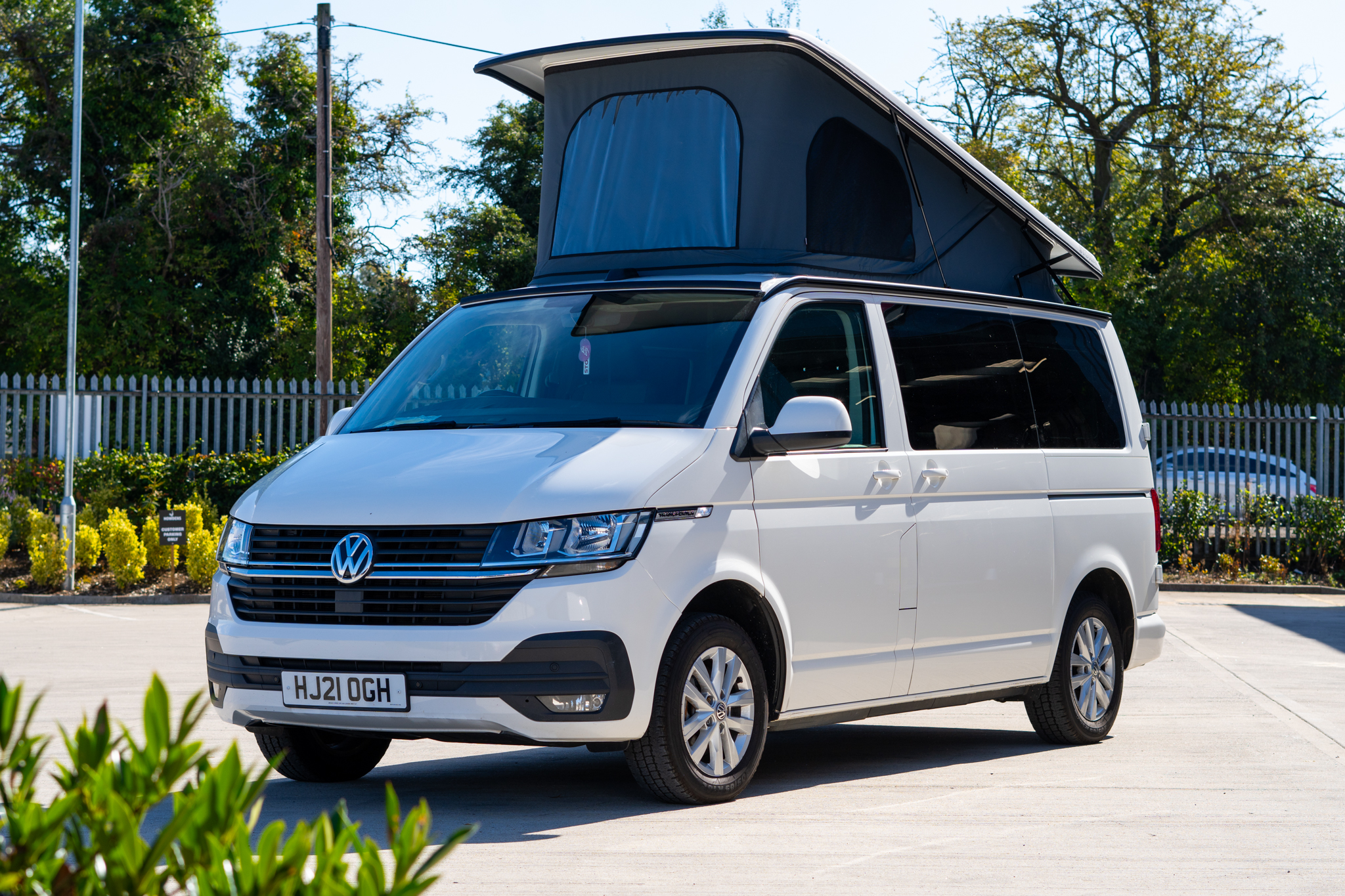Adding a Pop-Top Roof: Is It Worth It for Your Ford Transit Custom?
One question I get all the time is: “Is adding a pop-top roof really worth it for my Ford Transit Custom?” Fair question, it’s a big investment and a hassle to get set up at the best of times!
In this post, I’ll speak from first-hand experience (both living with a pop-top and installing countless ones at Cosmic Campervans) to give you an honest look at the benefits, challenges, and real-life realities of popping the top on your Transit Custom.
I’ll cover what a pop-top roof actually does, how it can transform your vanlife (comfort, space, road trips – you name it), and what to consider before you invest. By the end, you should have a pretty clear idea if a pop-top is the right move for you.
Why Add a Pop-Top Roof to Your Transit Custom?
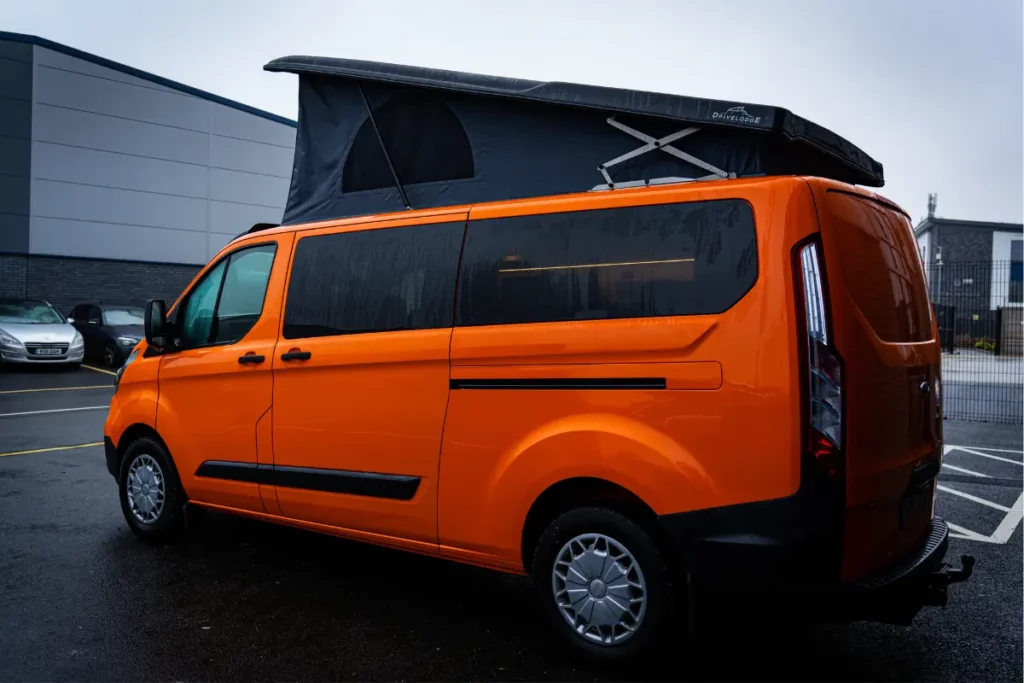
Imagine this: you pull up to a beautiful campsite in your Transit Custom. But it’s raining! Instead of being confined to crouching in your van, you release a few latches and push up the roof. Suddenly, your compact van has a roomy second story!
This is essentially what a pop-top roof does; it’s an elevating roof section (often with tent-like canvas sides) that you can pop up when parked to create extra headroom and even an additional bed space.
When it’s down, it sits almost flush with your original roofline, so you hardly notice it’s there.
In my opinion, a pop-top is one of the most impactful upgrades you can make without changing your van’s footprint.
You get the benefit of a higher roof only when you need it. When closed, the van remains low-profile, allowing you to drive and park it like normal.
In other words, you get the best of both worlds. A cozy camper with more space on demand, but the same van agility day-to-day.
Now, is it worth the cost and effort? To answer that, let’s talk about what you really gain from a pop-top in real life.
Upgrade Your Camper with a Pop-Top Roof
Transform your van into a multi-level living space. Pop-Top Roofs add a second sleeping area and more space.
How a Pop-Top Upgrades Your Van Life
I’ve lived the vanlife and built bespoke campers for years, so I’ve seen all the upsides of adding a pop-top roof to a Transit Custom. Here are the key benefits in my experience.
Extra sleeping space is great for travelling in groups
One of the biggest advantages is the additional sleeping area a pop-top provides. It’s like turning your van into a bunk-bed-on-wheels.
Most pop-tops for the Transit Custom can comfortably sleep two adults up top, or a few kids.
I’ve installed pop-tops for young families where the parents sleep “downstairs” in the regular bed and the kids clamber up the ladder to the roof bed – which they absolutely love, by the way. It transforms a two-berth camper into a four-berth, just like that.
Even if you don’t have kids, having that second bed is a game-changer when you’re traveling with friends or relatives. No need to lug around a tent or make someone sleep awkwardly across the van seats. Everyone gets a comfy spot.
Plus, the upstairs bed in a well-fitted pop-top usually comes with a supportive base and a memory foam mattress (that’s what we include in our installations), so it’s genuinely a cosy night’s sleep.
For solo travelers or couples, the pop-top can serve as a chill-out lounge when not used for sleeping. Or, I’ve also had customers that design the camper with the pop top as the only bed so that downstairs has heaps of room for seating and cooking.
Basically, a pop top widens your layout options by a ton!
Room to stand up and breathe (no more hunching over)
If you’ve ever spent time in a standard Transit Custom (or any van) without a raised roof, you’ll know the “hunchback shuffle” all too well. Crouching while cooking, bending awkwardly to get dressed, generally feeling cramped. A pop-top fixes that instantly.
With the roof elevated, most people can stand upright inside the van. At 6 feet tall, I can stand and stretch my arms in a Transit Custom with our pop-top installed, and it feels amazing.
This extra headroom isn’t just about comfort. It’s also about practicality and sanity. For example, I love cooking in my camper, but cooking in a van without a pop-top can be an absolute nightmare.
It gets stuffy and hot, and you’re bent over the stove the whole time. By the time dinner’s done, your neck and back are protesting. And the smells… oh man. Who wants to tuck into bed with last night’s curry aroma still hanging around? Not me!
With a pop-top, you can cook with proper ventilation. The heat and smells rise up and out, especially if you unzip the vent windows in the roof canvas. No more clattering around in a tiny airless box.
Lots of my customers have told me it completely changed their van cooking experience. On rainy UK mornings, being able to stand inside and make a brew without cracking your head on the ceiling is a small luxury that you quickly come to appreciate.
Beyond cooking, the ability to just move around normally, whether you’re changing clothes or stretching your legs, makes van life so much more enjoyable.
If you’re considering living in your Transit Custom for extended trips or full-time, I’d definitely recommend a pop-top for this reason. It keeps you from feeling claustrophobic on those days when the weather keeps you inside.
Better ventilation and scenic views
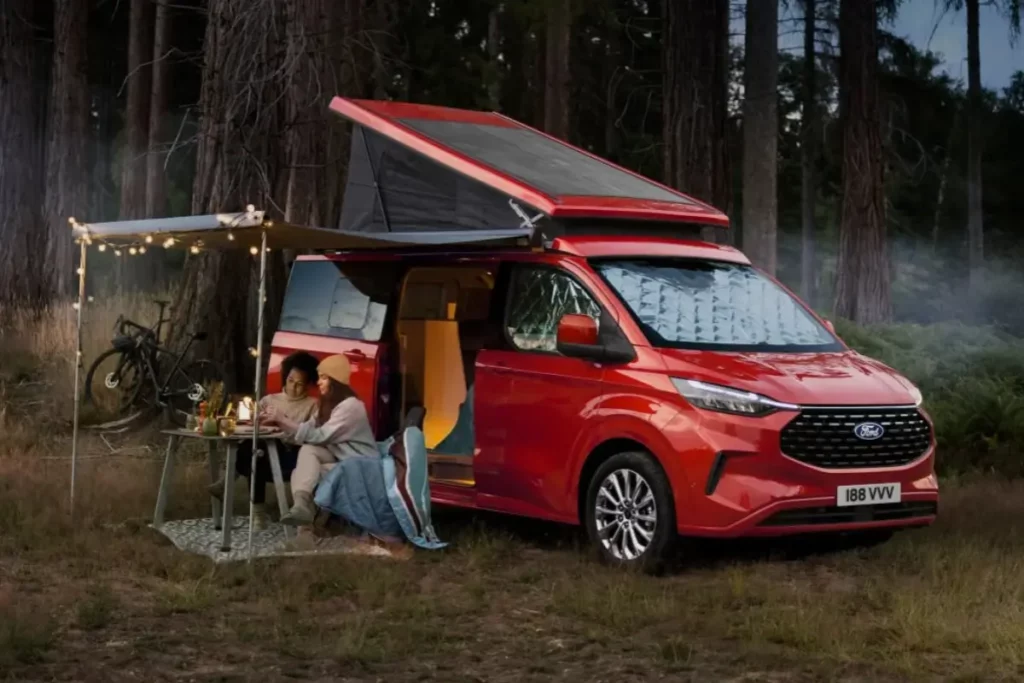
Most pop-tops are designed with zippered windows, mesh panels, or vents in the canvas. This means when the roof is up, you get better airflow through the van. No more condensation build-up in the mornings like you often get in a closed metal box.
When I install pop-tops, I always recommend including a scenic canvas upgrade (in fact, our Short Wheelbase STORM roofs come with this option). Basically it means the tent material has large window panels that can be unzipped.
Open those up and you can catch a breeze and also take in the surroundings from an elevated perch. It’s like having a built-in treehouse view!
On a clear night, you can peek out and see the stars, and in the morning, unzip the front canvas for a panoramic view over that beach or mountain you camped by.
Ventilation isn’t just about enjoyment; it’s also practical. If you’ve got a couple of people sleeping in the van, having that extra airflow up top means everyone sleeps more comfortably. In summer, you won’t feel like you’re suffocating inside a tin can.
And if someone accidentally burns the toast on the camper stove, no worries because the smoke has somewhere to go! Many pop-tops even come with built-in mosquito nets on the openings, so you can ventilate without inviting in the midges (handy in summer!)
It’s all these little quality-of-life improvements that make a pop-top so appealing.
Install a Diesel Heater For Warmth
A fuel efficient solution for comfortable winter camping
Low-profile when closed
You might be thinking: “Isn’t an elevated roof going to make my van too tall for car parks and garages?” Good news! Pop-tops hardly change your van’s exterior height when closed.
The added height is usually just a matter of a few centimeters of the fiberglass shell sitting on top. In practical terms, your Ford Transit Custom with a pop-top can still sneak under that 2.0m or 2.1m car park barrier (model depending), and you can still use it as an everyday vehicle.
In my opinion, this is a huge advantage over a fixed high-top van conversion, which permanently raises the roof height and can limit where you go.
In fact, one big reason I love the Transit Custom + pop-top combo is that it keeps the van versatile. I’ve done conversions for folks who use their van for work (delivery, trades, etc.) on weekdays and then as a camper on weekends.
With the pop-top down, a Transit Custom doesn’t scream “motorhome.” This stealth factor can be nice for urban stealth camping or just not drawing attention.
Also, because the van is more aerodynamic when the roof is down, you’re not adding a big drag box on top like you do with a high top. That helps maintain decent fuel efficiency on the highway (fixed high roofs can increase wind resistance).
So, I also recommend a pop top to people who aren’t used to driving vans or big vehicles – the drag from a high top can feel scary really quickly if you’re not used to it.
With a pop top, you get your standing room and sleeping loft at camp, but you’re not sacrificing drivability or MPG during travel. It’s really the best of both worlds: space when parked, slim profile when moving.
Boosted resale value of your van
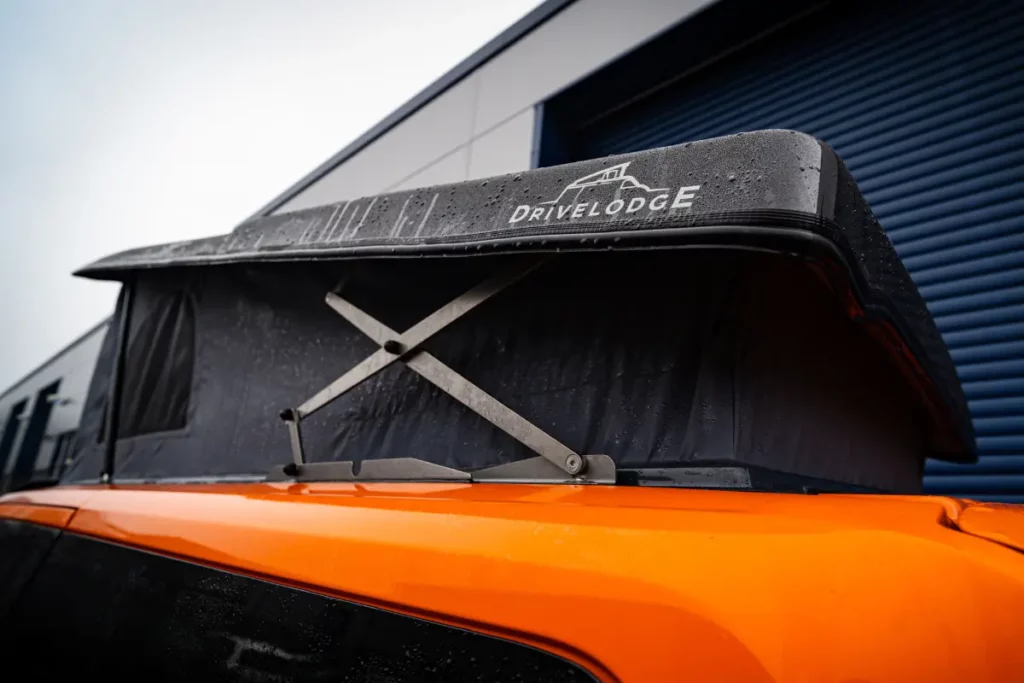
Here’s something many people don’t realize: a high-quality pop-top conversion can hugely increase your van’s resale value. Campervans are in high demand, and a Transit Custom with a professionally installed pop-top is especially desirable because not all vans have them.
Think about it… you’re effectively turning your van into a full-fledged camper with more sleeping capacity and headroom. When it comes time to sell or upgrade, buyers are usually willing to pay a premium for those features.
Of course, the boost in value assumes the pop-top is good quality and installed properly (more on that in a bit). A shoddy DIY job might hurt your value, whereas a pro install (with certification and warranty) is a strong selling point.
I’ve had customers tell me that knowing their roof has things like safety certifications and a warranty gives buyers peace of mind too when they eventually sell the vehicle. It’s like extra insurance that the camper was done right.
Now, I’m not saying you should add a pop-top purely as an investment to flip your van. But it’s nice to know that this upgrade is seen as a valuable asset.
In many cases, if you eventually sell, you can recoup a good chunk of the pop-top cost because it made your van so much more attractive to others. Meanwhile, you get to enjoy all the benefits in the years between. Win-win!
So, those are the major benefits in my experience: more space (both for living and sleeping), more comfort, better views/ventilation, everyday usability, and even financial upside.
For most Transit Custom camper enthusiasts, these are pretty compelling reasons to go for it. But as with any big modification, you should also think about any challenges you might be up against. Let’s discuss those next so you have the full picture.
Challenges and Considerations of Adding a Pop-Top
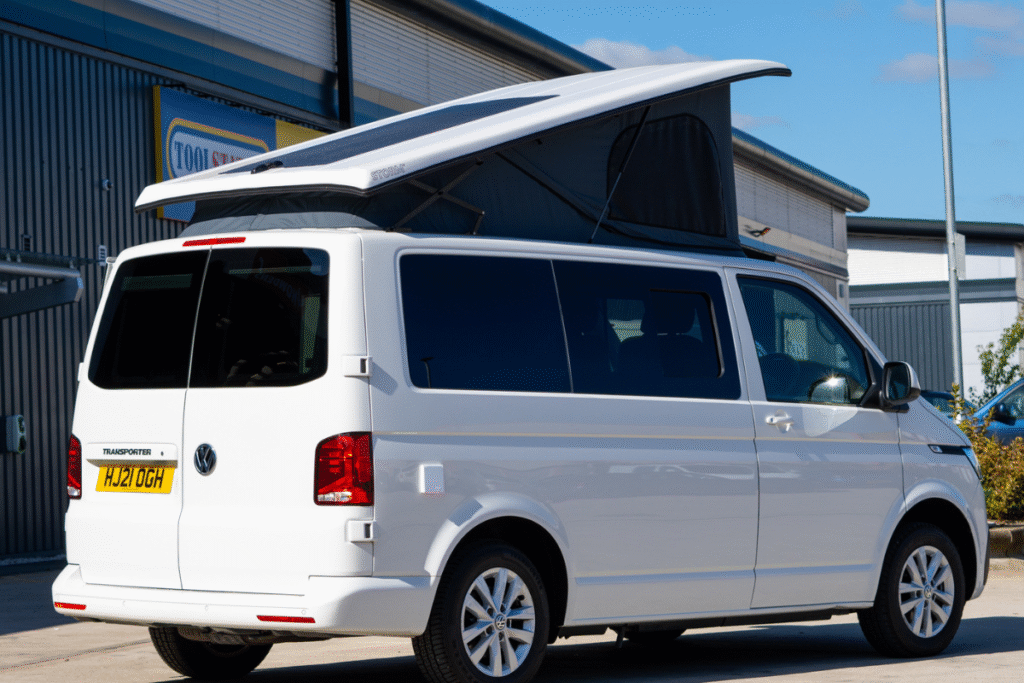
I’m a huge fan of pop-tops, but I’ll be the first to tell you it’s not all sunshine and rainbows. There are some practical considerations and trade-offs to keep in mind before slicing open your van’s roof. Here’s my honest take on the challenges:
The upfront cost (and why quality matters)
There’s no avoiding this one: a pop-top roof is a significant investment. By the time you purchase a quality roof and pay for a professional installation, you’re usually looking at several thousand pounds.
In our case at Cosmic Campervans, all-inclusive pricing for a Ford Transit Custom pop-top conversion is around the £5,000 mark (I’ll break down our specific options in a moment). It’s a decent chunk of money, no doubt about it.
You might be tempted by cheaper options from less experienced converters. After all, who wouldn’t want to save a couple grand? Well, let me warn you I’ve personally seen the consequences of going too cheap on a pop-top, and it’s not pretty. Buy cheap, buy twice, as the saying goes.
For example, a customer came to me recently with a Transit Custom that had a bargain-basement pop-top fitted (I think he paid about £2,000 for it elsewhere). Within 18 months, the thing was leaking badly.
The gel coat on the roof had defects, water seeped in during rains, and it caused mould in his van’s insulation and wrecked some interior panels. The hinges were already rusting and the whole roof creaked on the motorway due to a flimsy frame.
In the end, he paid us to rip it out and install a proper one. So that “cheap” route cost him more in the long run. This is why I strongly advise investing in a high-quality pop-top from the get-go.
What’s the difference with a high quality pop top?
High-quality pop-tops (like the ones we use) have properly engineered frames that maintain your van’s structural integrity, thick waterproof canvas that won’t rip, durable seals, and rust-proof hardware.
They also come with good warranties. We provide a 5-year warranty on all our pop-top installs. Compare that to many budget ones that might only give you 1 or 2 years of coverage (if that).
The roof is a big hole you’re putting in your van; you want to trust that it’ll stay weathertight and solid for many adventures to come.
How much does pop top roof installation cost?
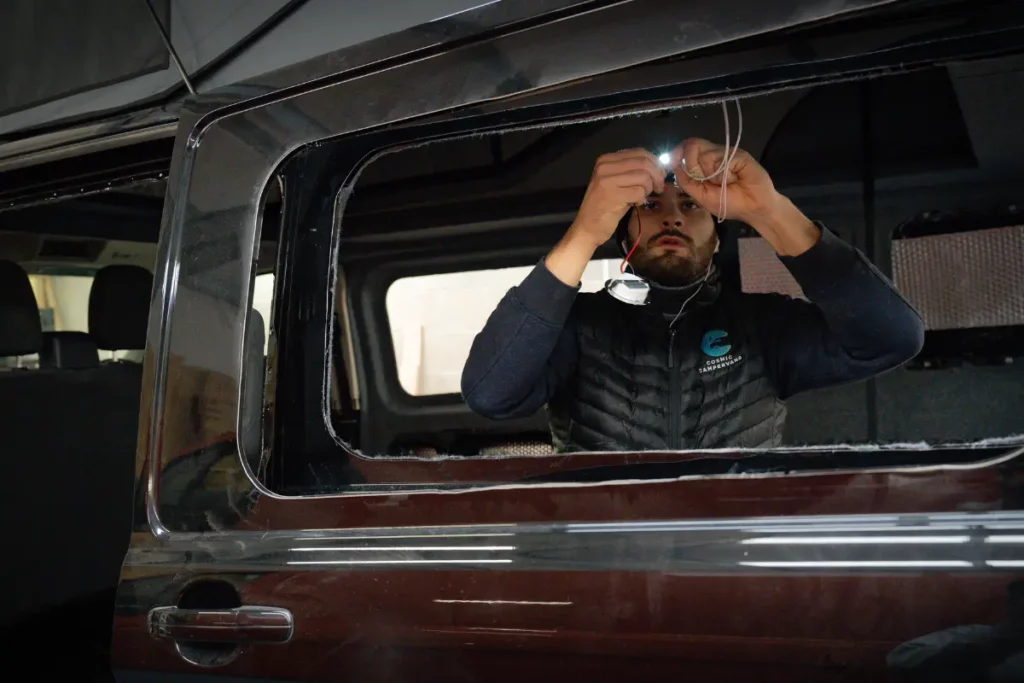
To give you an idea of cost: At Cosmic Campervans we offer two premium pop-top roof options for the Ford Transit Custom depending on your van’s wheelbase:
- SWB (Short Wheelbase) – STORM Pop-Top Roof: £5,454 (includes VAT and installation)
- LWB (Long Wheelbase) – Drivelodge Pop-Top Roof: £4,815 (includes VAT and installation)
Those prices reflect the quality of the product and the work involved. Both the STORM and Drivelodge models are top-tier British-made roofs that we are authorised installers for.
They come with that 5-year warranty, a gloss polished finish (in black or white gel coat), integrated bed boards, LED lighting kits, and we carpet-line all the interior metal that gets exposed after the roof cut. In short, it’s a professional, all-inclusive package.
Sure, you might find a no-name roof for half the price, but as someone who’s fixed the aftermath of those, I can’t stress enough: do it right, do it once.
A Transit Custom pop-top done properly will serve you well for years; a cheap one might barely last a couple of seasons before causing headaches.
Never Run Out of Power on the Road
Install solar panels in your camper van for endless energy on your journey.
What to consider if you want to DIY a pop top
Speaking of doing it right, let’s talk installation. Adding a pop-top is not a simple DIY job for most people.
It involves literally cutting a large opening in the roof of your van, reinforcing that opening with a frame, bonding and bolting the new roof shell on, and making sure every seam is sealed up tight.
The alignment has to be perfect so that the roof opens and closes smoothly and is watertight. If the cut or install is off by even a small amount, you could have water ingress or wind noise issues (or worse, structural weakness).
It’s a precise, complex process that usually takes a professional converter a few days to complete.
In my workshop in Derby, we’ve honed our pop-top installation process to an art. If you’re considering DIY, unless you’re very experienced with metalwork, carpentry, and have the right tools, it’s probably not worth the risk.
I’m all for people getting hands-on with their vans, but a pop-top is one area where calling in an expert is usually the best path. The peace of mind knowing the roof has been fitted correctly is huge, especially when you’re driving down the motorway in a rainstorm and not getting dripped on!
Another consideration: professional installers (like us) will also finish the interior around the roof – we trim out the cut area with proper seals and carpet so it looks factory, and wire in the LED lights, etc.
It ends up looking seamless, as if the van came with the pop-top from new. That level of finish can be hard to achieve DIY unless you’ve done it before. So factor installation quality into the “worth it” equation.
Weather and insulation factors
Using a pop-top is slightly different than a fixed roof when it comes to weather. Cold weather camping for instance: a pop-top’s canvas walls aren’t as insulated as solid metal.
If you camp a lot in winter or frosty conditions, you’ll probably need an extra thermal wrap or liner for the pop-top. These are basically insulated jackets that go around the tent portion to keep the heat in better.
I use one whenever I take my van snow camping. It makes a noticeable difference in warmth and also keeps condensation off the canvas. It’s an extra accessory to think about, but not a huge deal (and I can guide you on sourcing one if needed).
Rain and wind
A good pop-top will be 100% waterproof, so camping in rain isn’t an issue in terms of leaks. The one on my own van has survived some gnarly Derbyshire downpours without a drop inside. But, heavy rain can be a bit noisy drumming on the roof canvas right above your head.
And strong winds (let’s say you’re camping on a hill in a storm) can make the roof area shake a little or at least make you more aware that you’re basically in a tent on top of a van. Some folks choose to keep the roof down in very high winds for peace of mind.
Personally, I haven’t often needed to do that, but it’s something to be aware of. The Transit Custom pop-tops we install have robust scissor hinges and gas struts that lock the roof pretty firmly in place, so they handle wind well, but any pop-top will have some movement because of the flexible canvas sides.
One practical tip: if your pop-top canvas gets wet, try to dry it out before sealing it down for a long time. This is the same advice as any tent; stow it wet and you risk mildew. If I pack up in the rain, I’ll pop the roof back up when I get a chance at home or when the weather clears to let it air dry.
All our canvas is mildew-resistant, but still, good habit to have.
Pop tops require some maintenance
A pop-top does introduce a bit of upkeep. You’ll want to occasionally clean the canvas (just brush off any dirt or use mild soapy water if it’s muddy), lubricate the hinges once or twice a year, and check the seals for wear after severe winters.
These are minor tasks that I spend maybe an hour or two a year on. But it’s worth noting as a responsibility that comes with pop-top ownership. Treat your pop-top well and it will return the favor with many years of trusty service.
So, Is a Pop-Top Roof Worth It?
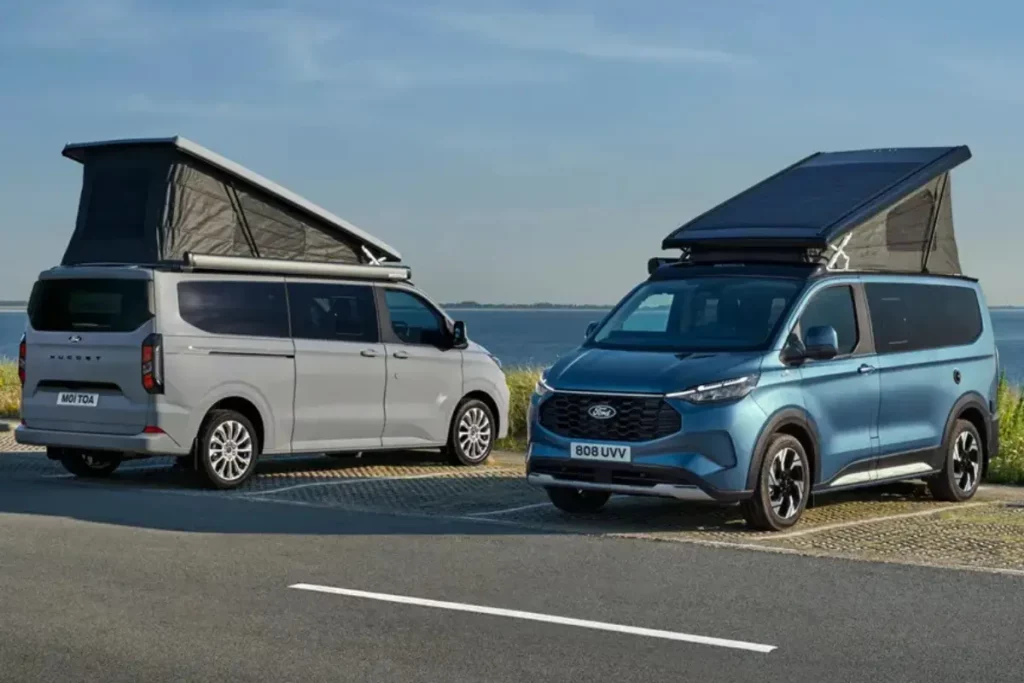
By now, you can probably guess my answer: absolutely, yes. I recommend a pop top for most Ford Transit Custom owners who want to get the most out of their van, a pop-top roof is worth every penny.
It’s one of the best upgrades you can invest in if you’re serious about campervan life. The added space, comfort, and versatility truly turn your Transit Custom into a home-on-wheels that can adapt to adventures big and small.
Of course, it’s a major investment and not something to rush into without thought. You’ll want to ensure you go for a quality product and have it installed by people who know what they’re doing.
But when done right, a pop-top will reward you with years of incredible road trip experiences. In my experience as both a van converter and a van traveler, I’d say the lifestyle improvement is immense. It takes your Transit Custom from a basic van or even a basic camper, and elevates (literally!) it into something so much more functional and fun to use.
If you’re still on the fence or have questions specific to your situation, feel free to reach out. Since we’re based in Derby in the UK, I’m always happy to have fellow Transit Custom enthusiasts drop by our workshop to see some pop-tops in person or chat about what’s involved.
Sometimes, seeing one up close, opening and closing it yourself, really solidifies how it all works. As a hands-on expert in this field, my goal is to make sure you have all the info you need to make the best decision for your van.

